Diving - The adventure continues!
2021 Diving - Plymouth Charter Weekend
Every year we try to go to Plymouth, usually in June, for a weekend's diving.
2020's trip had gone the way of most things in 2020, but we booked for 2021 as much in hope as anticipation.
Things didn't start too well as the owners of the guesthouse we usually block book announced they weren't reopening, so we hurriedly booked our own accommodation.
Way back in 2012, I'd done a PADI Wreck Course in Plymouth over a couple of weekends and stayed at the Barbican Reach guesthouse and found it very comfortable and Rob, the owner, very welcoming, so I booked myself in there again.
The drive to Plymouth was not a great deal of fun, taking around 3.5 hours through the typically heavy coastbound traffic that is the norm for 2021, but I arrived mid-afternoon and had a wander around in the sunshine, after spending the first 100 miles of the trip in pouring rain and spray.
Others arrived throughout the afternoon and evening and we met up on the Barbican where we managed to find a table in a pub, despite it being one of England's first matches of the Euros.
The weather looked good and it seemed we may be able to do the dives that we had planned, which doesn't always happen.
It was a pre-7 AM start (so no cooked breakfast, sadly, although I was left cereal, yoghurt, fruit and juice to get me on my way) on the Saturday and I drove over the Mount Batten boatyard.
Although this is only a few hundred yards from the Queen Anne's Battery yard we've used previously, as the crow flies, it's a 15 minute drive from there, but I arrived in plenty of time and unloaded my kit along with the others.
One advantage of this site is there is free parking close by, QA Battery always cost a significant amount per day.
Pete, the Skipper, and Mark, his crew for the day, arrived in Venture, the boat we usually use and we loaded everything aboard.
As we motored out, the sea was lovely and flat and the sun was shining.
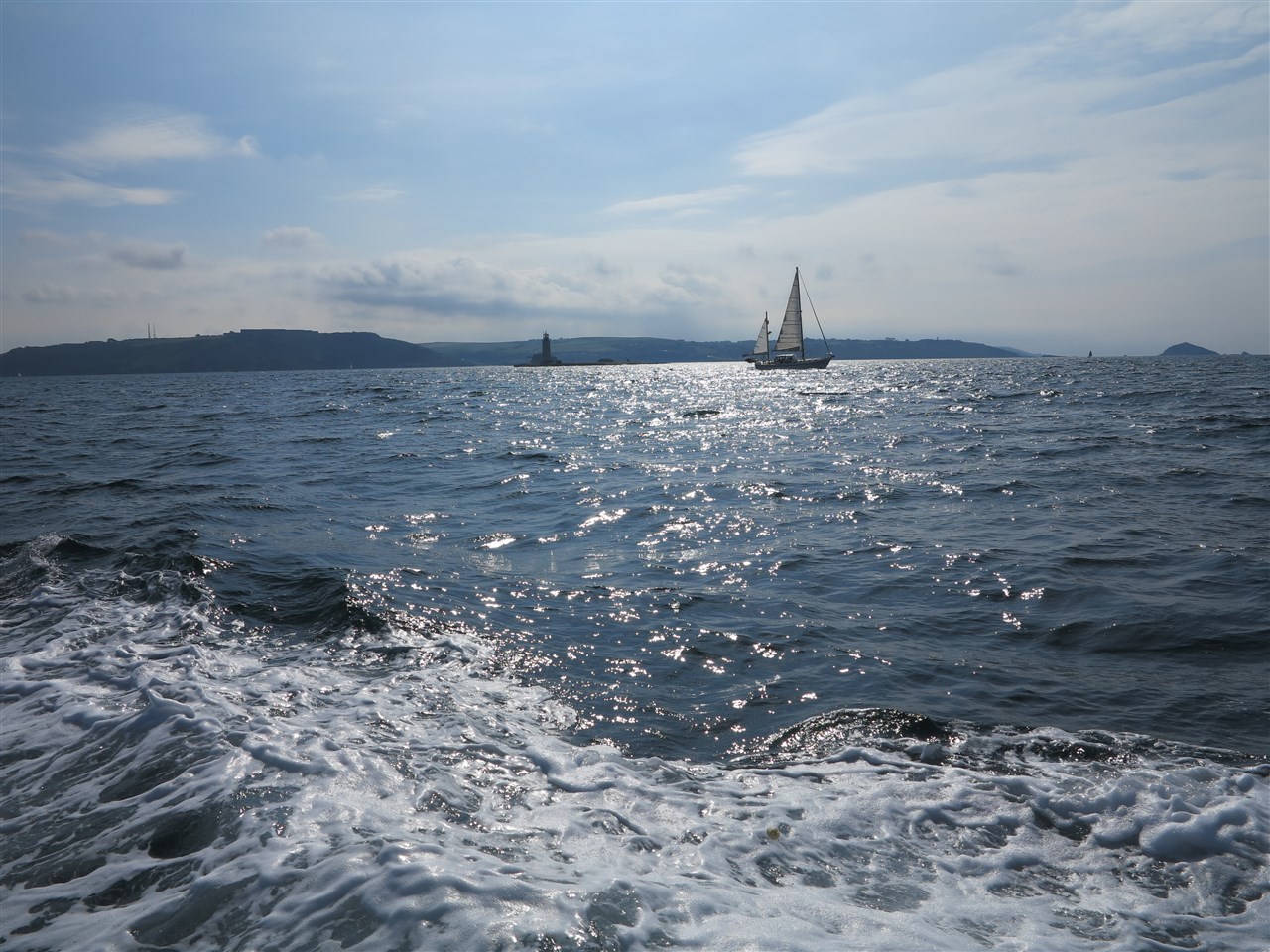
Fine weather in Plymouth
Our dives on the Saturday were both close to Plymouth and each other and familiar to us.
The first dive was on the SS Rosehill, a WW1 wreck that sits at around 30M and I was paired with Ria on this dive.
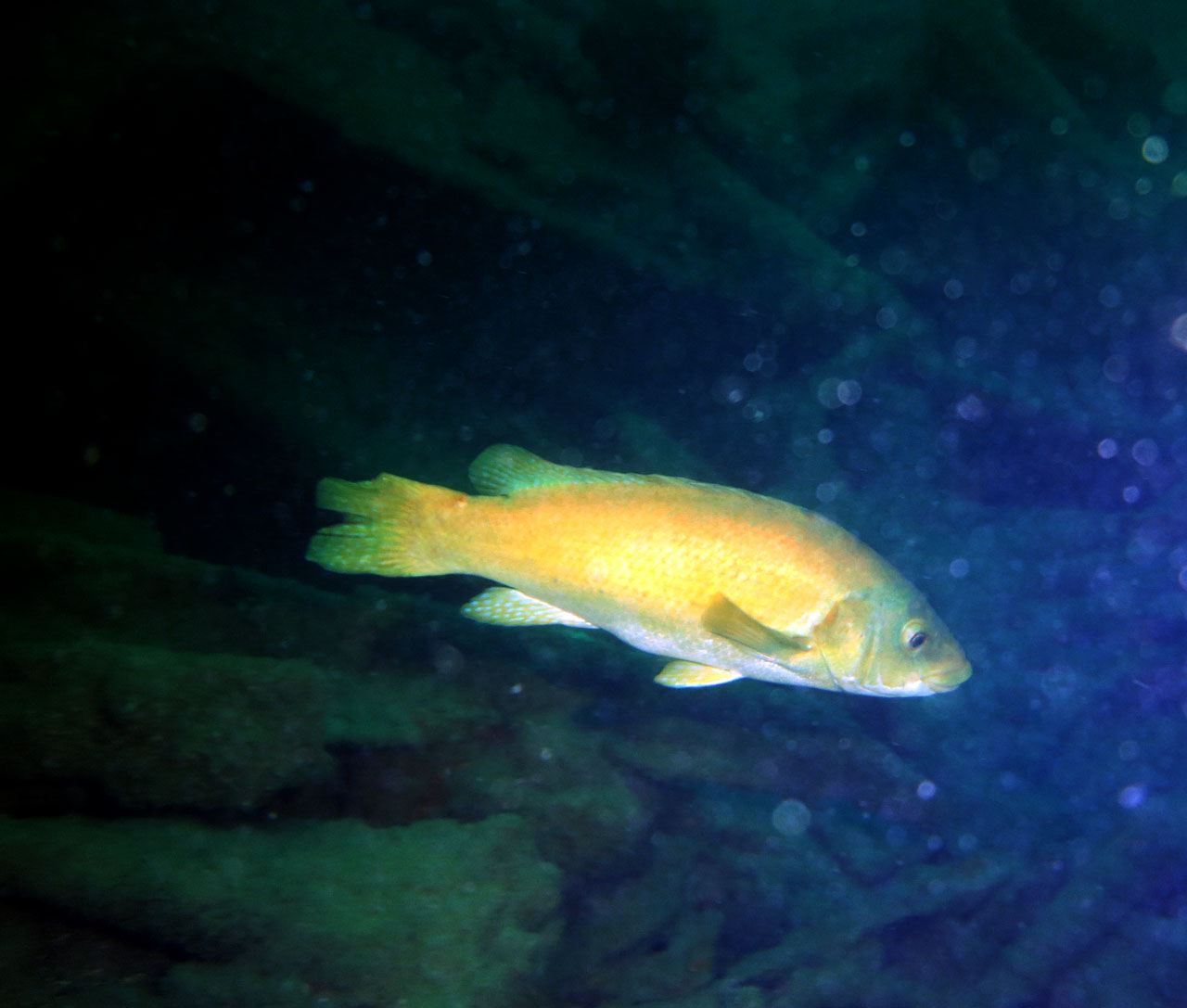
Ballen Wrasse
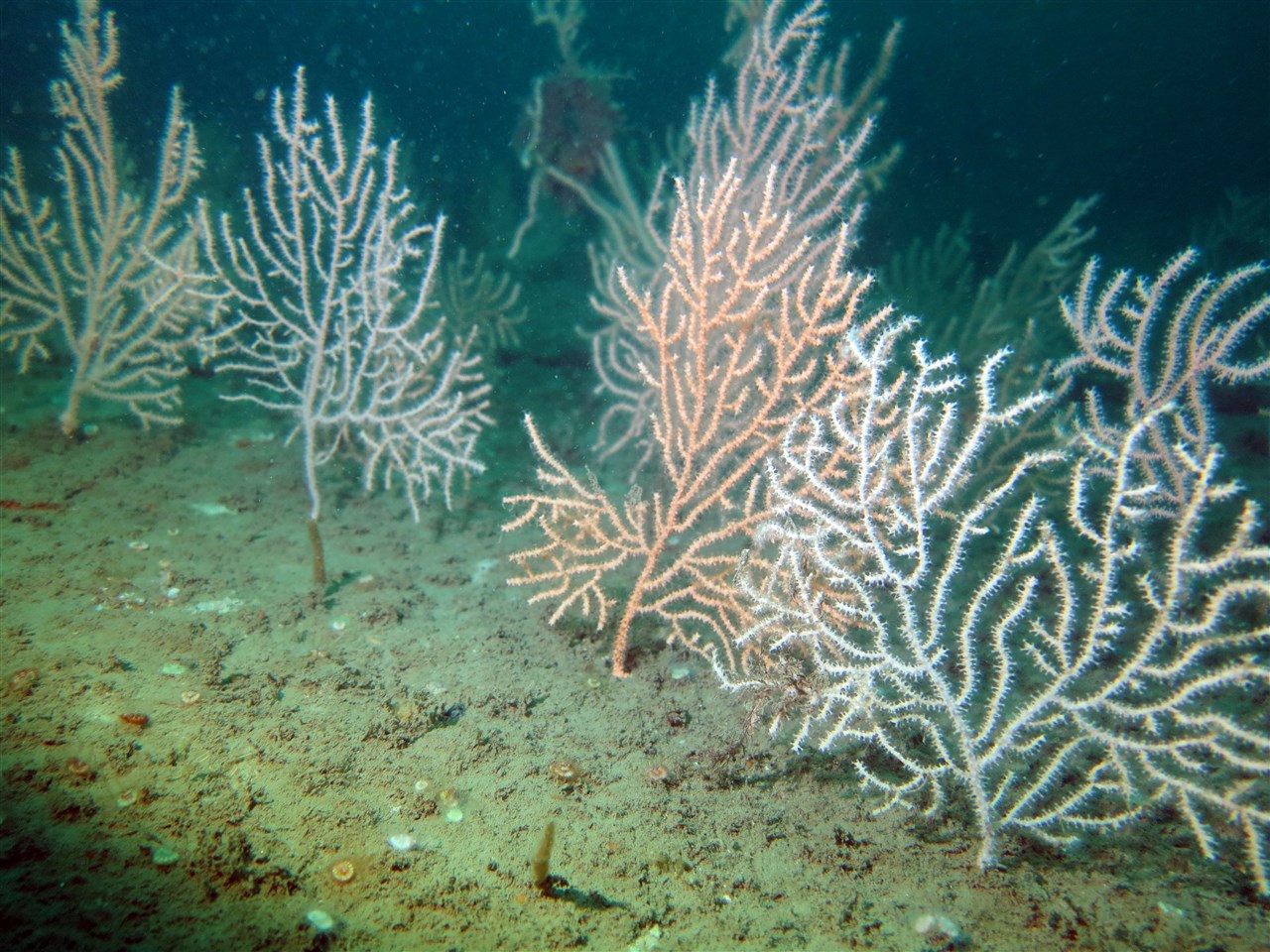
Sea fans on the boiler
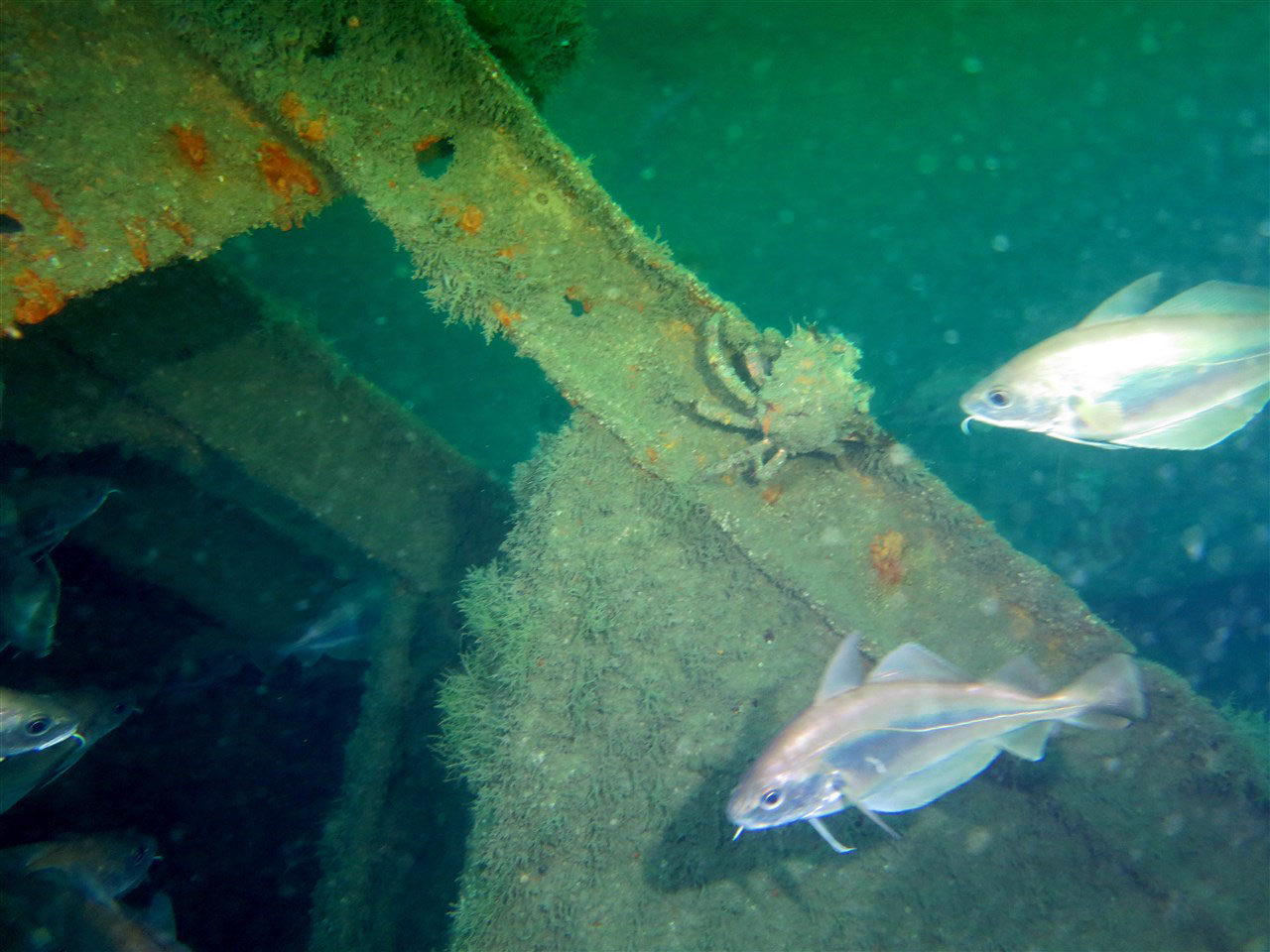
Wrecks are great for life as well
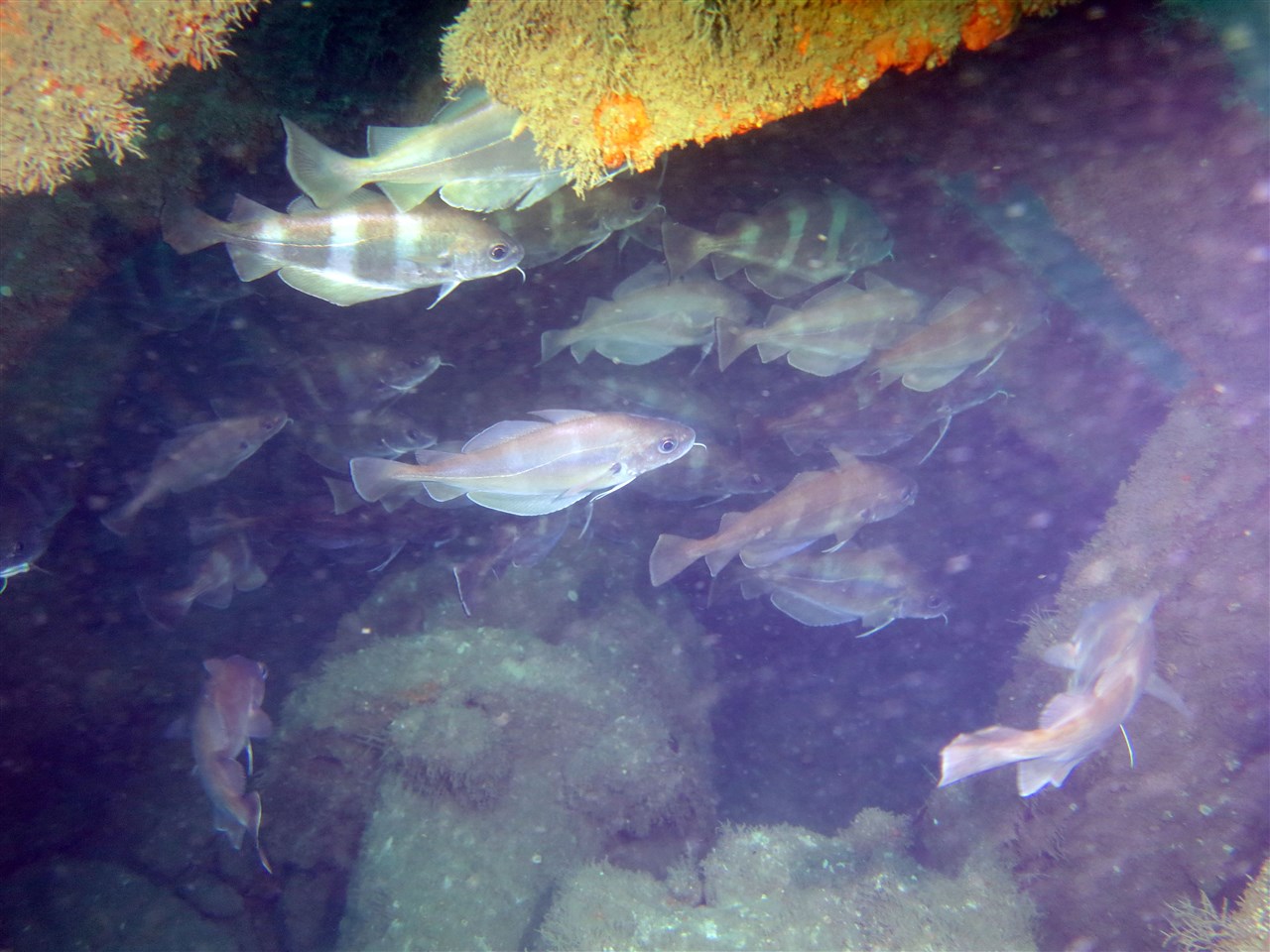
Bib especially love the wreckage
We'd dived this a few years ago and enjoyed it, but the light was far better this dive, enabling us to see further and understand the layout of the wreck better.
We landed by the boilers and engine and could see the vis was excellent - Easy 10M.
The wreck was full of life and Ria and I immediately swam towards what turned out to be the stern as most of the others had headed in the opposite direction.
We found a propellor sticking out of the seabed here, so realised we were at the very rear of the wreck and then, as we moved back around the area looking at a jumble of crushed machinery, I spotted the unmistakable shape of the 6 pounder deck gun, complete on its mount.
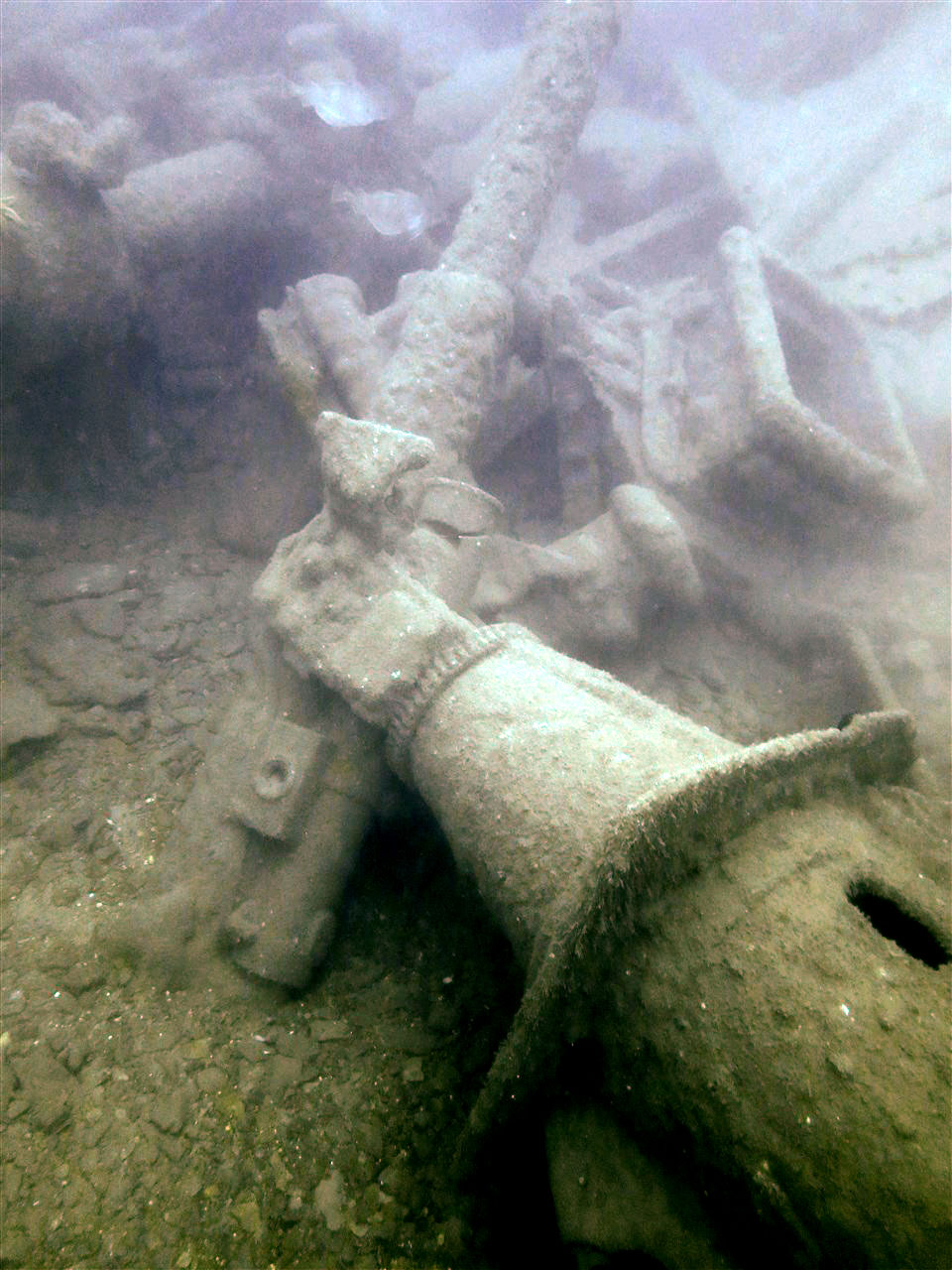
Stern mounted gun lies amongst wreckage at stern
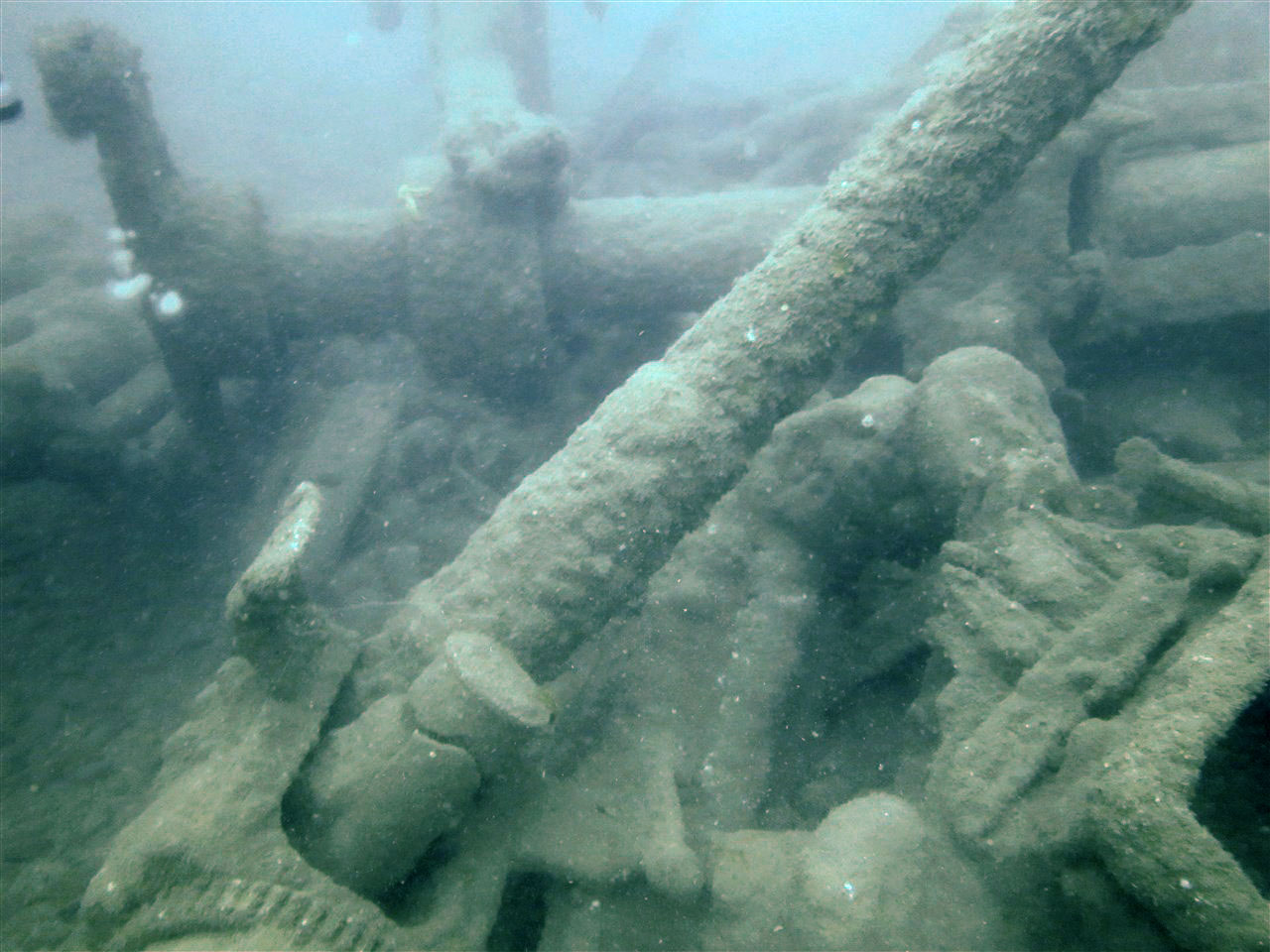
Closer look at gun
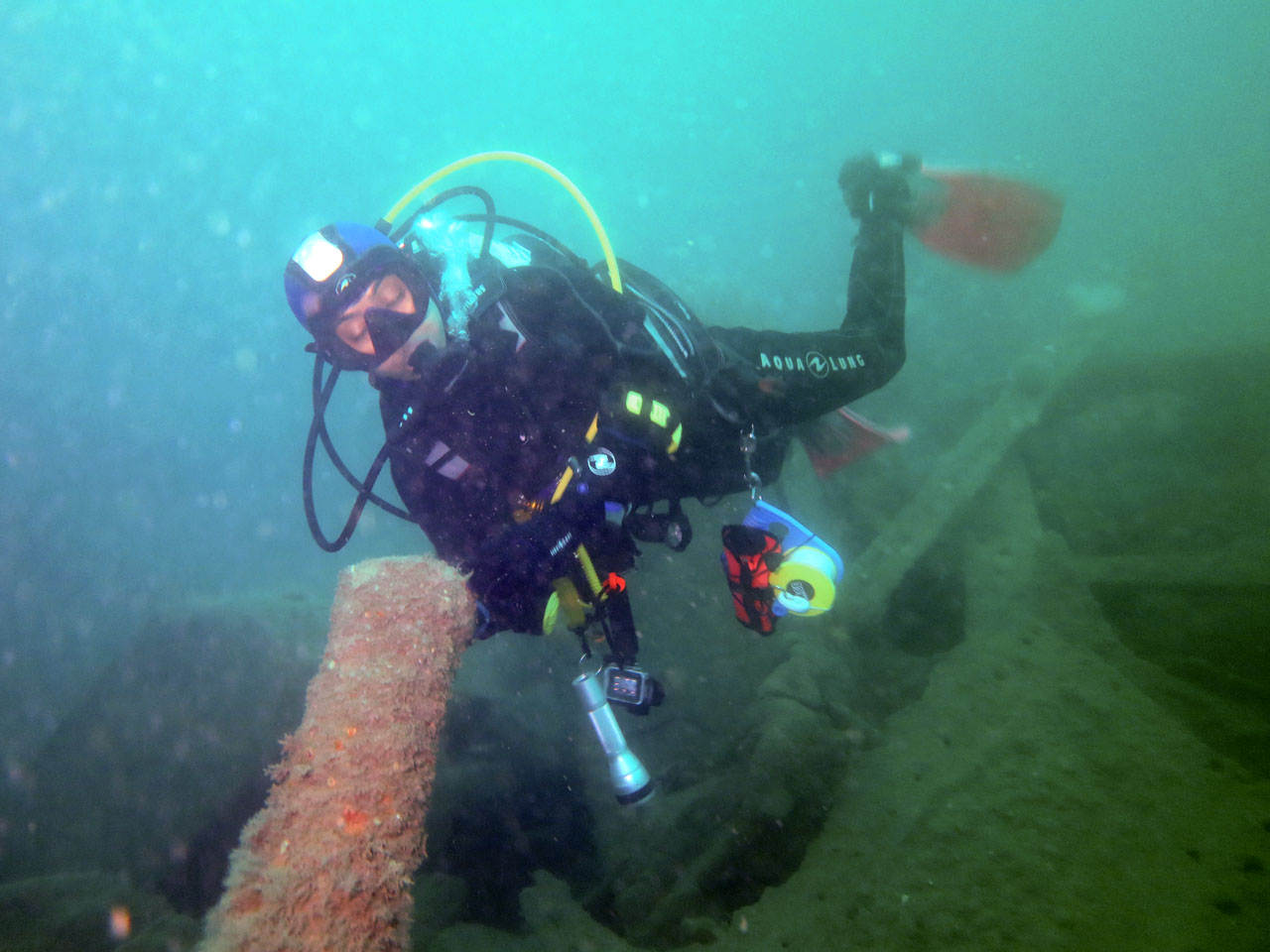
Ria examines the gun - She swears she hadn't fallen asleep!
We took some more photographs here and then swam back towards the bow, reaching the boilers again just in time to deploy the DSMB with a couple of minutes mandatory deco time.
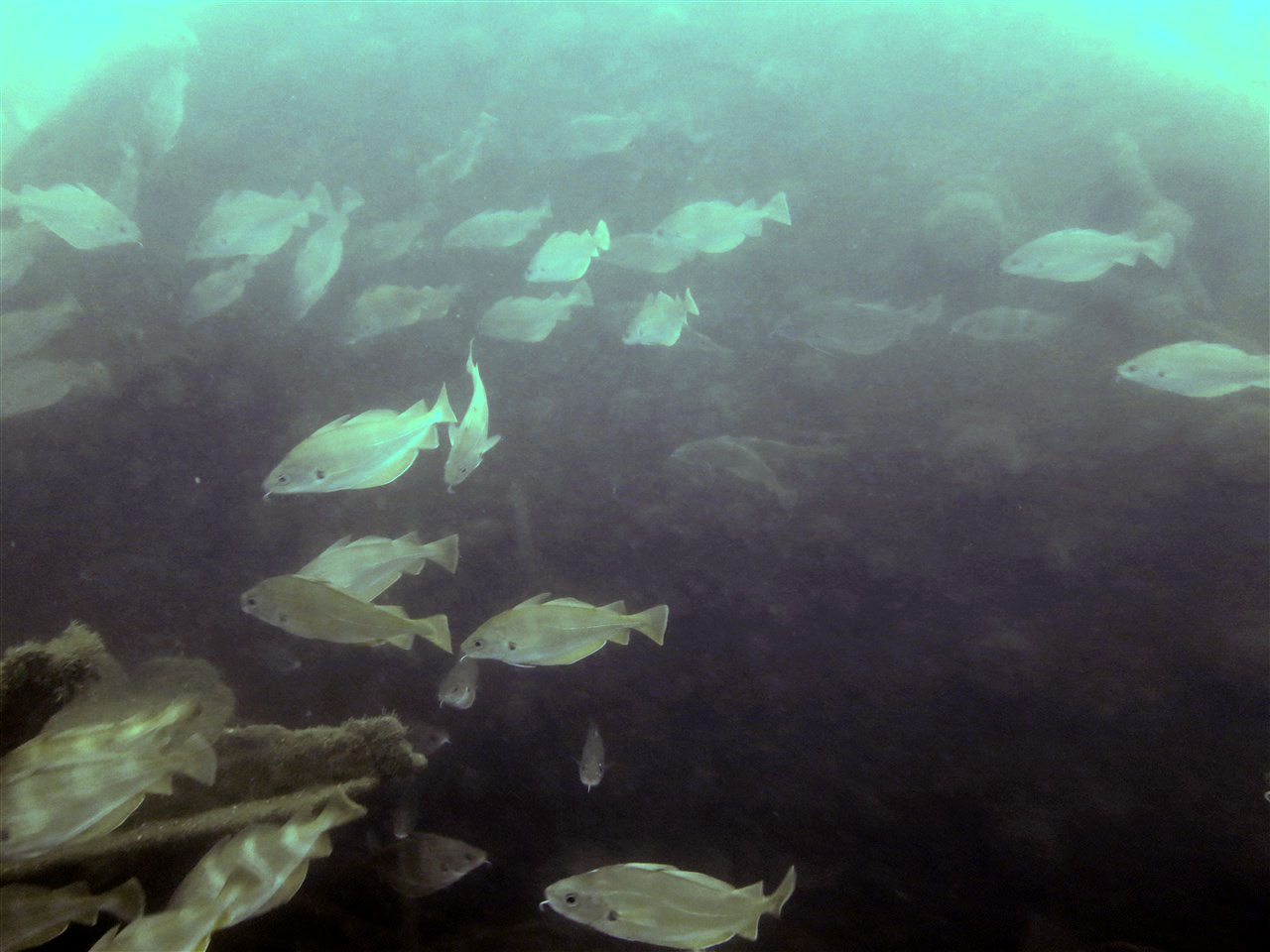
One of the boilers
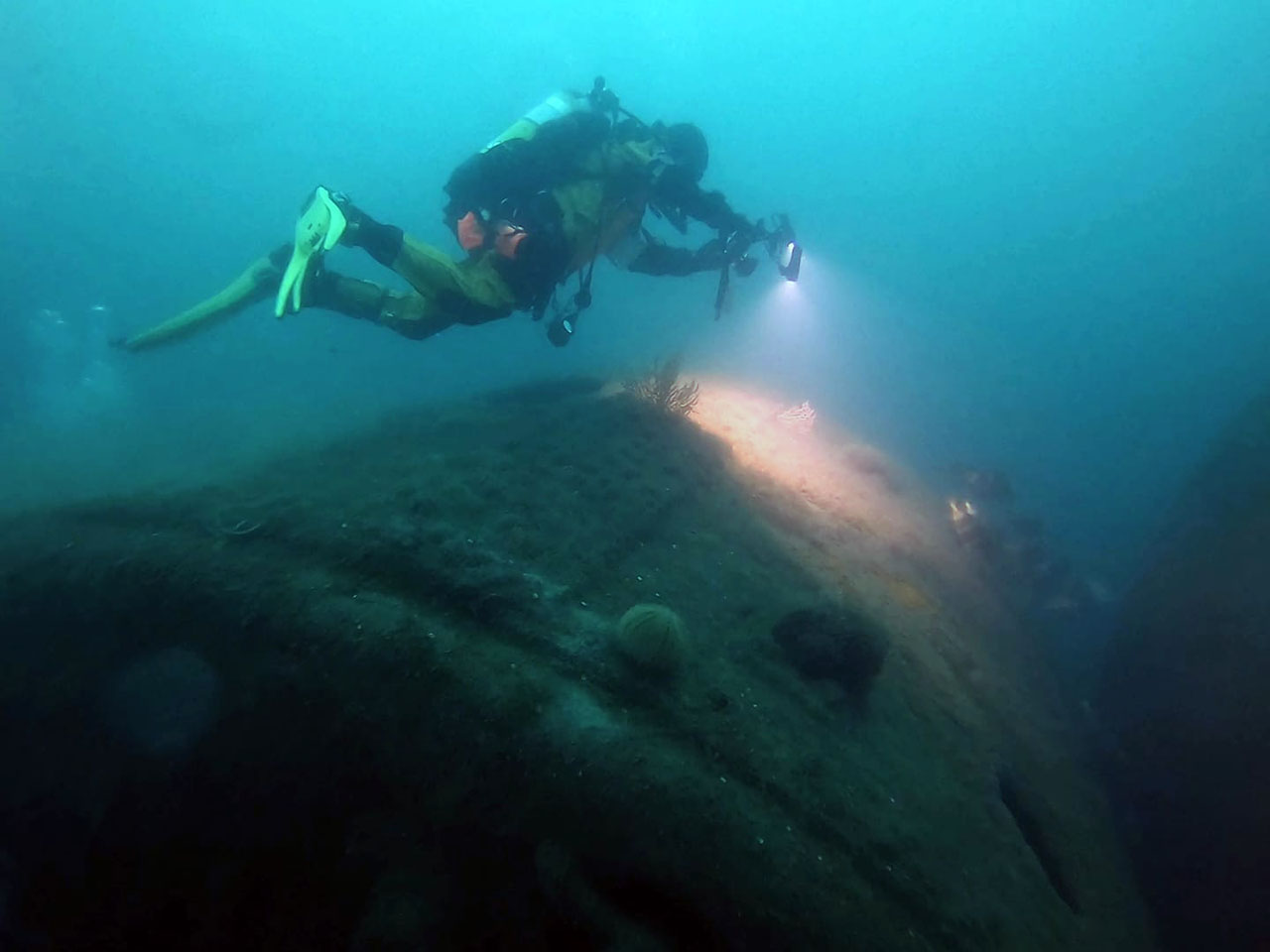
A rare shot of me diving - Courtesy of Ria
As we ascended, though, this eked away and we reached 6 metres with none remaining - Ria and I completed a safety stop and then surfaced to return to Venture after an excellent first dive of the weekend.
Back on board, everyone was happy and excited, all having enjoyed the dive.
Mark arrived with warm pasties when we moored in the shelter of a nearby headland ahead of our second dive of the dive, HMS Scylla.
This is a wreck we always do, the 70's Frigate being still pretty intact but more and more taking on the form of the artificial reef it was sunk to be.
It is undoubtedly falling apart though, as more and more of the internal structure is collapsed each time we visit.
For this dive, I joined Chris.
We went in first and were asked to check the shot.
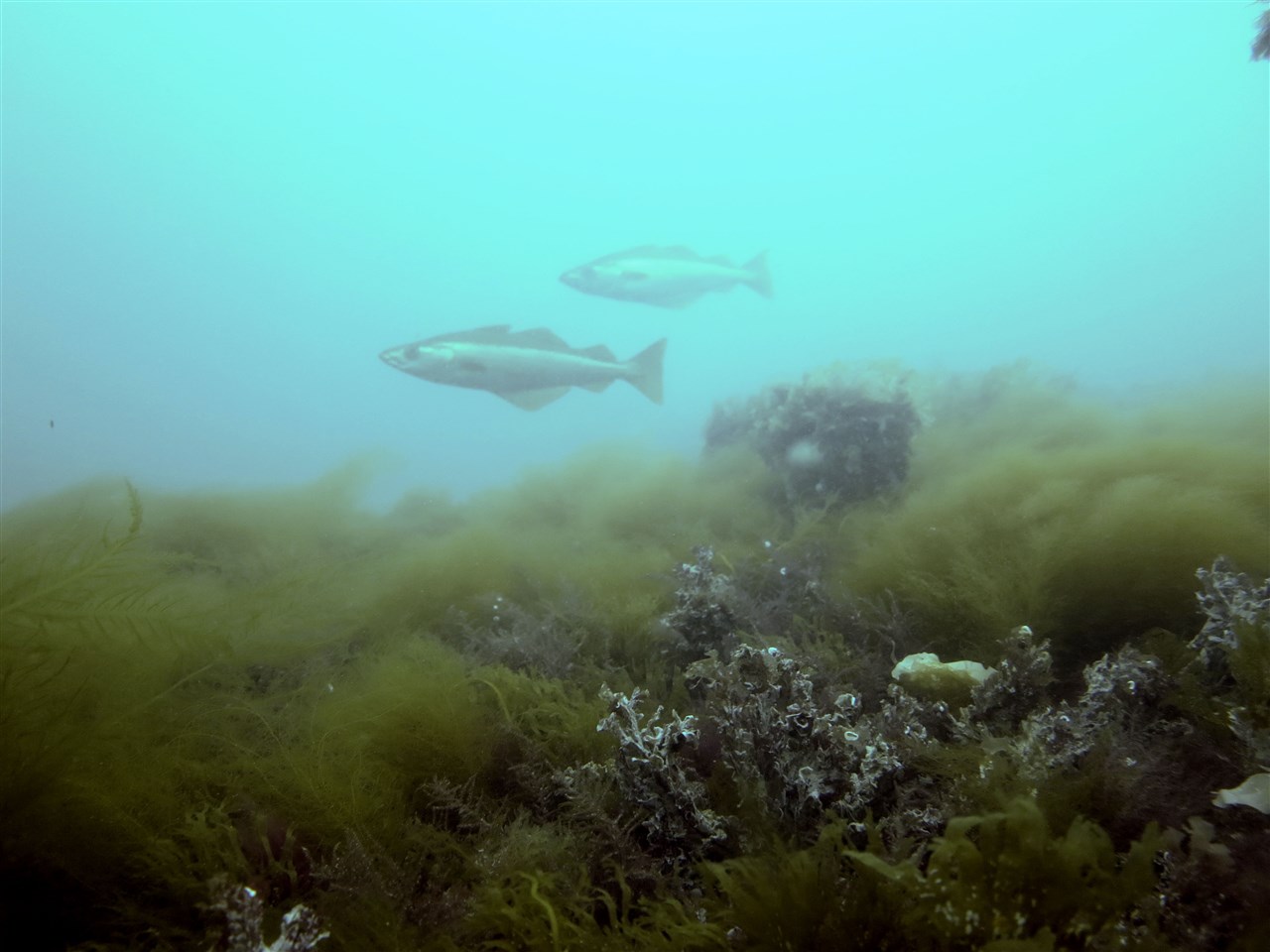
Larger fish often cruise deck
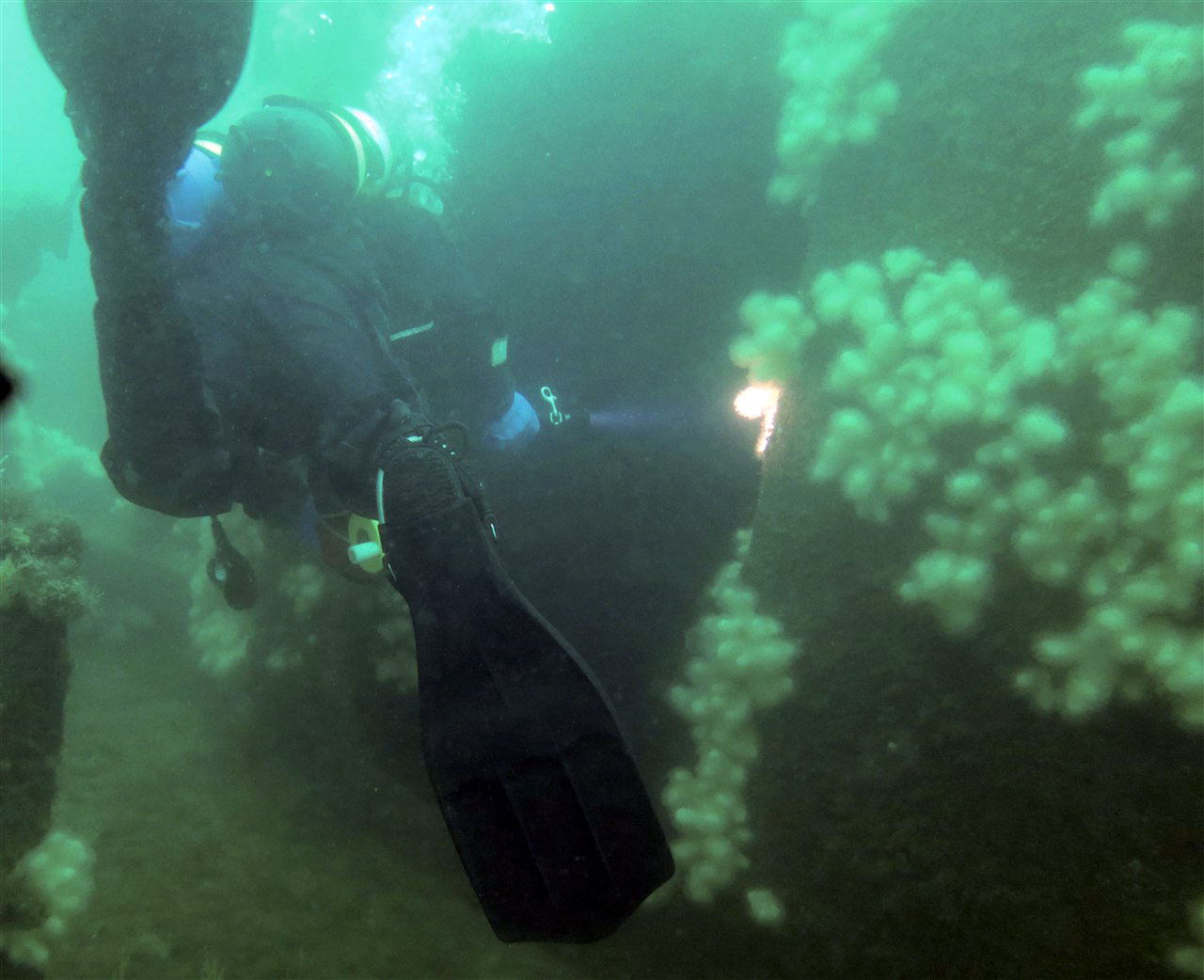
Chris explores an opening
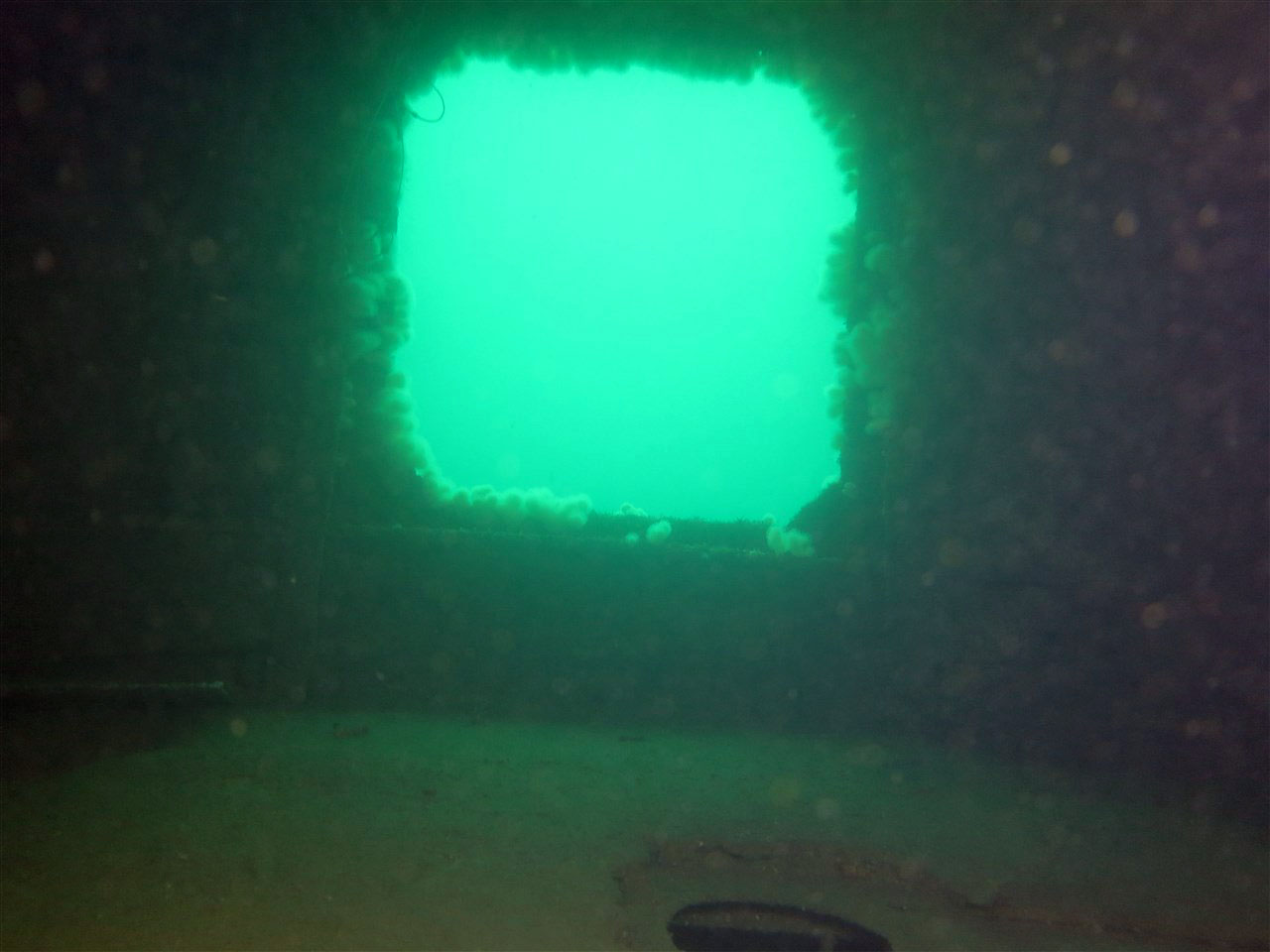
Light draws us out of the wreck
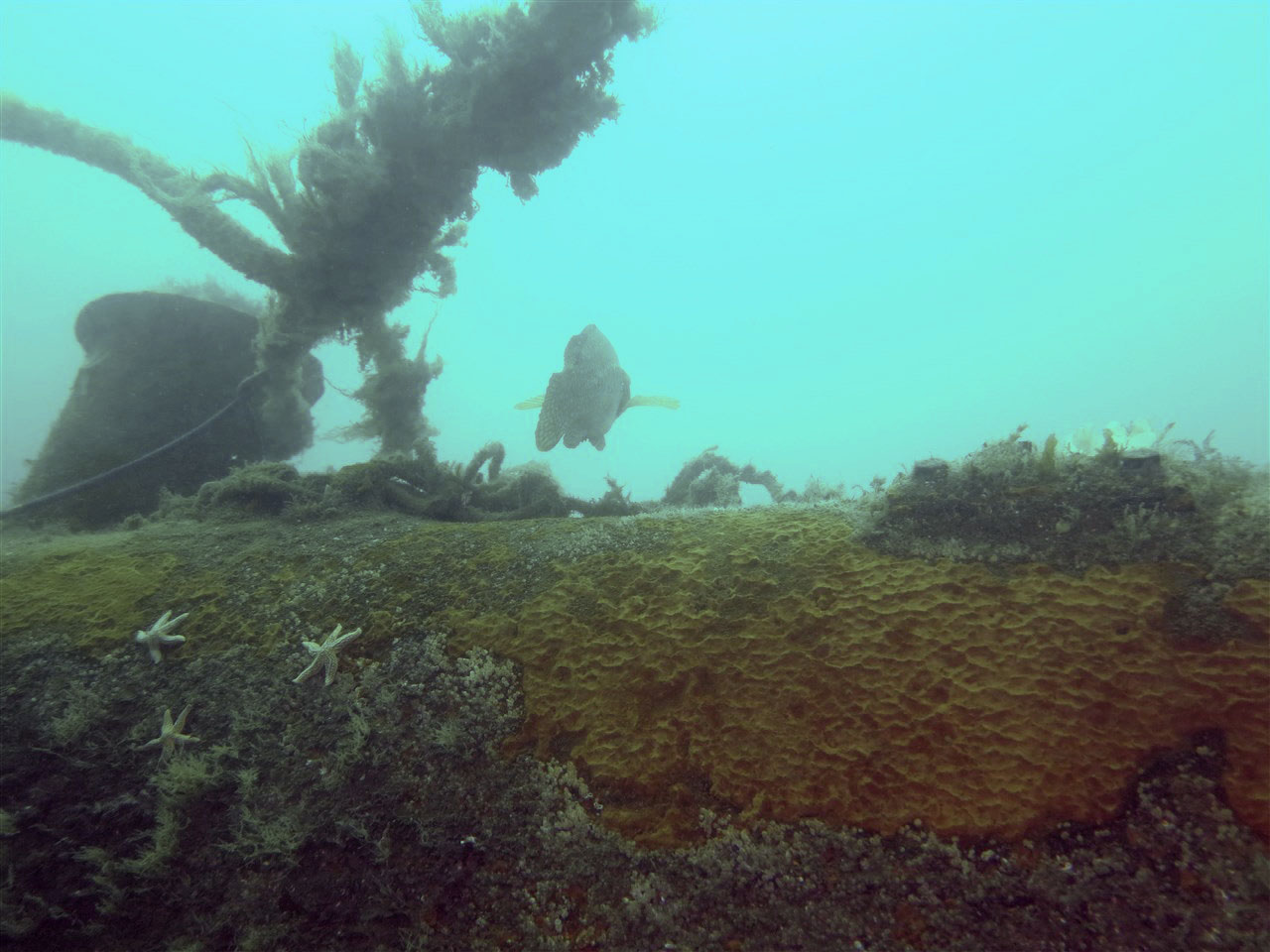
Ballen Wrasse heading up the hull to the deck
Chris realised it had dropped into a hole in the upper deck, so lifted it out and placed it on the deck plating, but it immediately was pulled across the deck and fell over the side, but wasn't long enough to fall to the sea bed and started to move away from the wreck.
We swam out it to and returned it to the hull, where Chris placed it somewhere relatively securely just as Julian and Rohit arrived.
I'd used quite a lot of my air doing this, so we explored around the outside of the hull, mostly, only dropping briefly to the seabed and not reaching the stern or very front of the bow.
We swam into a few of the openings, passing through from one side to another a couple of times, but most showed no light, so we decided not to venture too deep with limited gas.
Our final entry showed strong light from above, so we swam in and then found ourselves in the funnel shaft and floated up through it to reach the top of the hull, just behind the bridge.
At this point a couple of divers passed us, so I suggested Chris could follow them while I ascended, but he declined and we both ascended on my DSMB at this point.
Vis wasn't as good as on the Rosehill, probably 6-8M, but it certainly wasn't bad for the Scylla, just not as good as it sometimes is.
We were back early enough for a nice warm shower (although I certainly hadn't felt as cold as I had last time I'd been diving to 30M) and a relax before heading back to the Barbican, less than a 5 minute walk for me, for dinner.
Everyone agreed the day had gone well and we were all looking forward to Sunday's dive, most of all the opportunity to dive the Maine, which Chris had brought to our attention.
This wreck is quite a journey from Plymouth (almost 2 hours on Venture) and the tides here are unpredictable, so getting away early was important, so it was another cold breakfast start.
The boat was loaded just in time and we started out. There was a slight swell under an overcast sky, but nothing terrible (Dawn suffered, as she often does, but no-one else), but when we arrived it was clear there was still a strong current running. It took nearly an hour for it to abate and even when it did, I seriously thought for a couple of minutes that there was no way I could make my way down (or along, so steep was the angle) the shot to the wreck, but as we went down it got easier.
As we'd waited though, the clouds had broken and we started the dive in sunshine.
I jumped in with John Taylor (diving together as we both had stages for ADP), battling the initially very strong current on the shotand found the shot was secure on the deck, so there was no need to relocate it as we had been asked to.
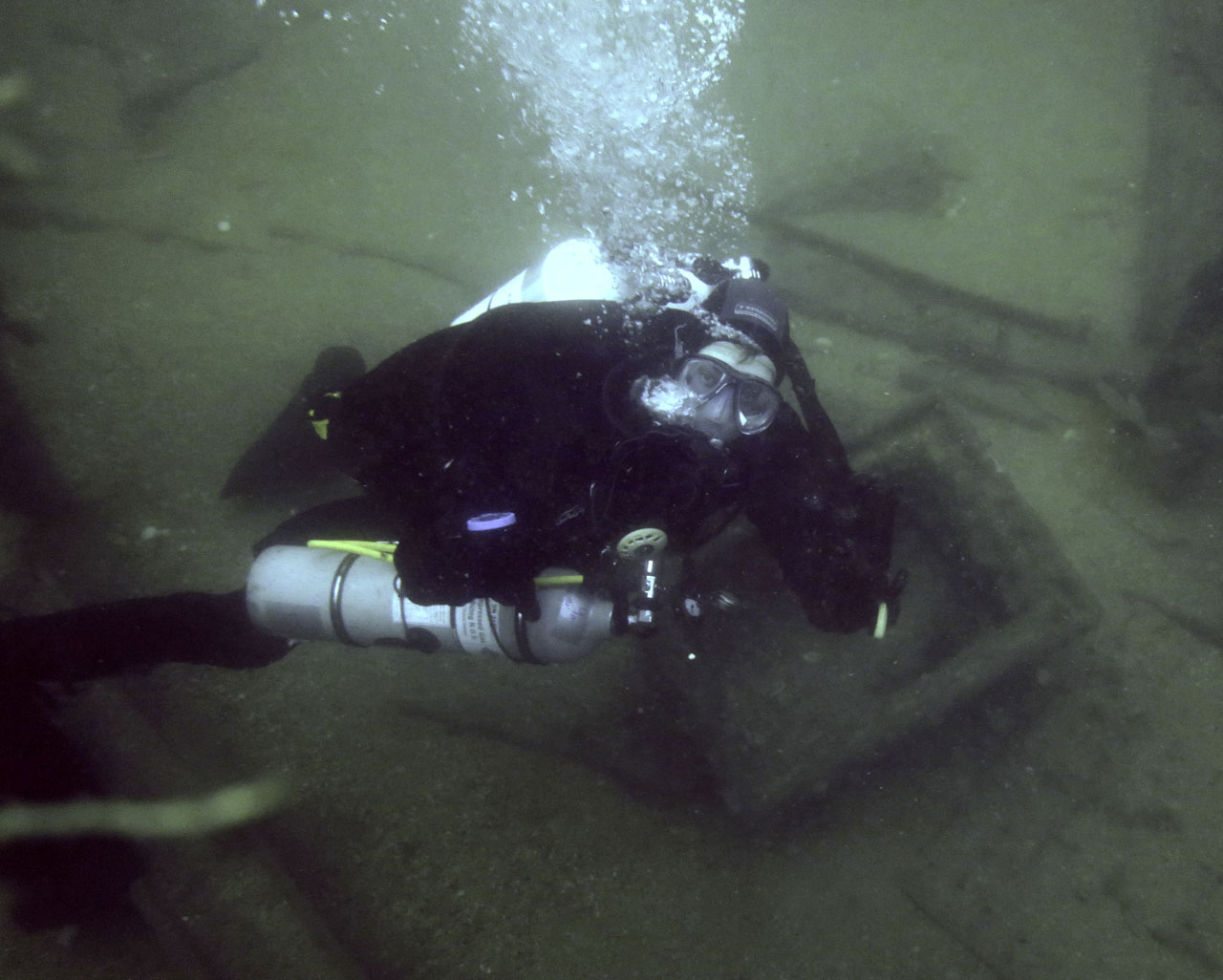
John checks I'm OK on reaching the wreck
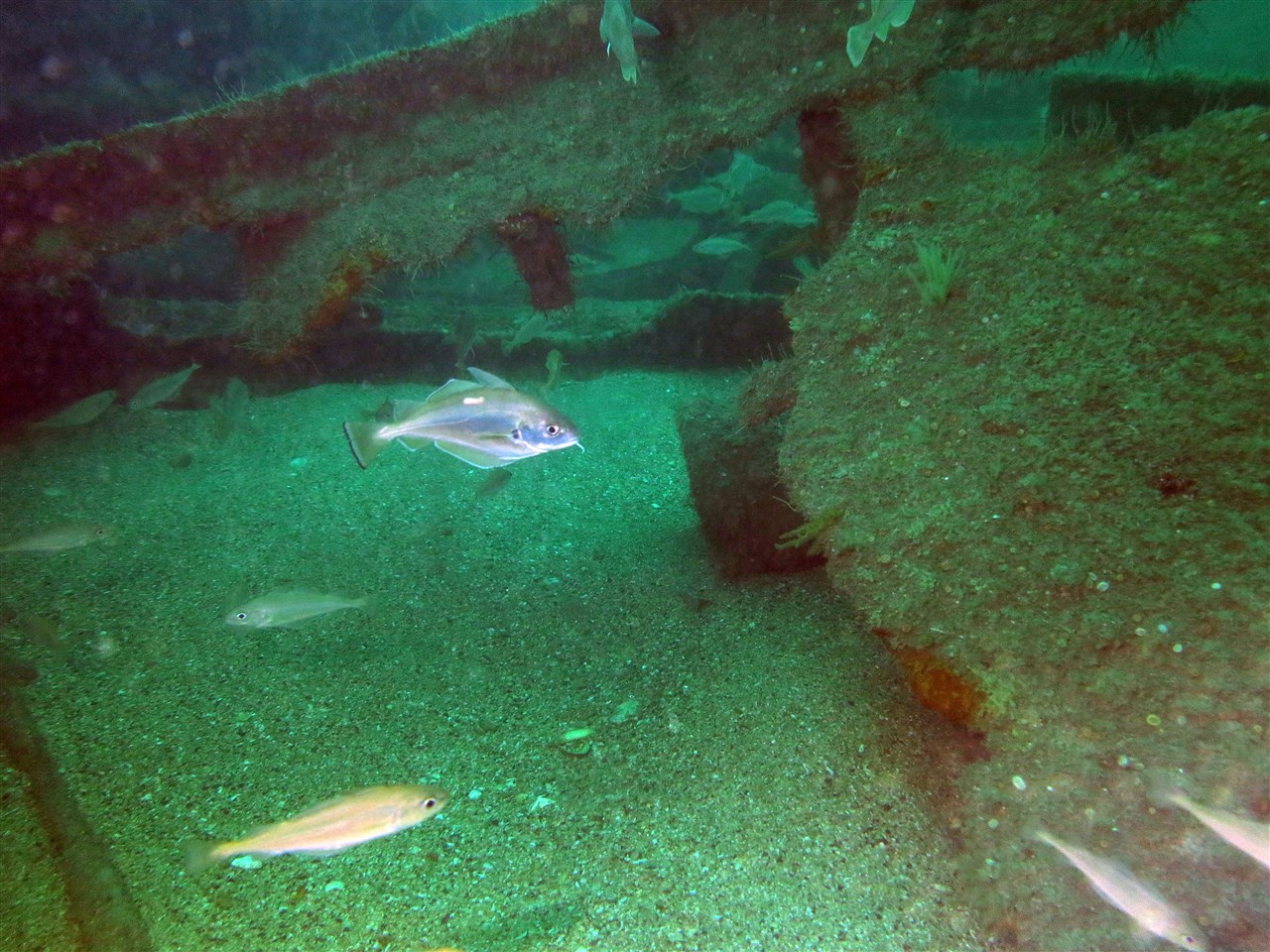
Huge wreck is full of life
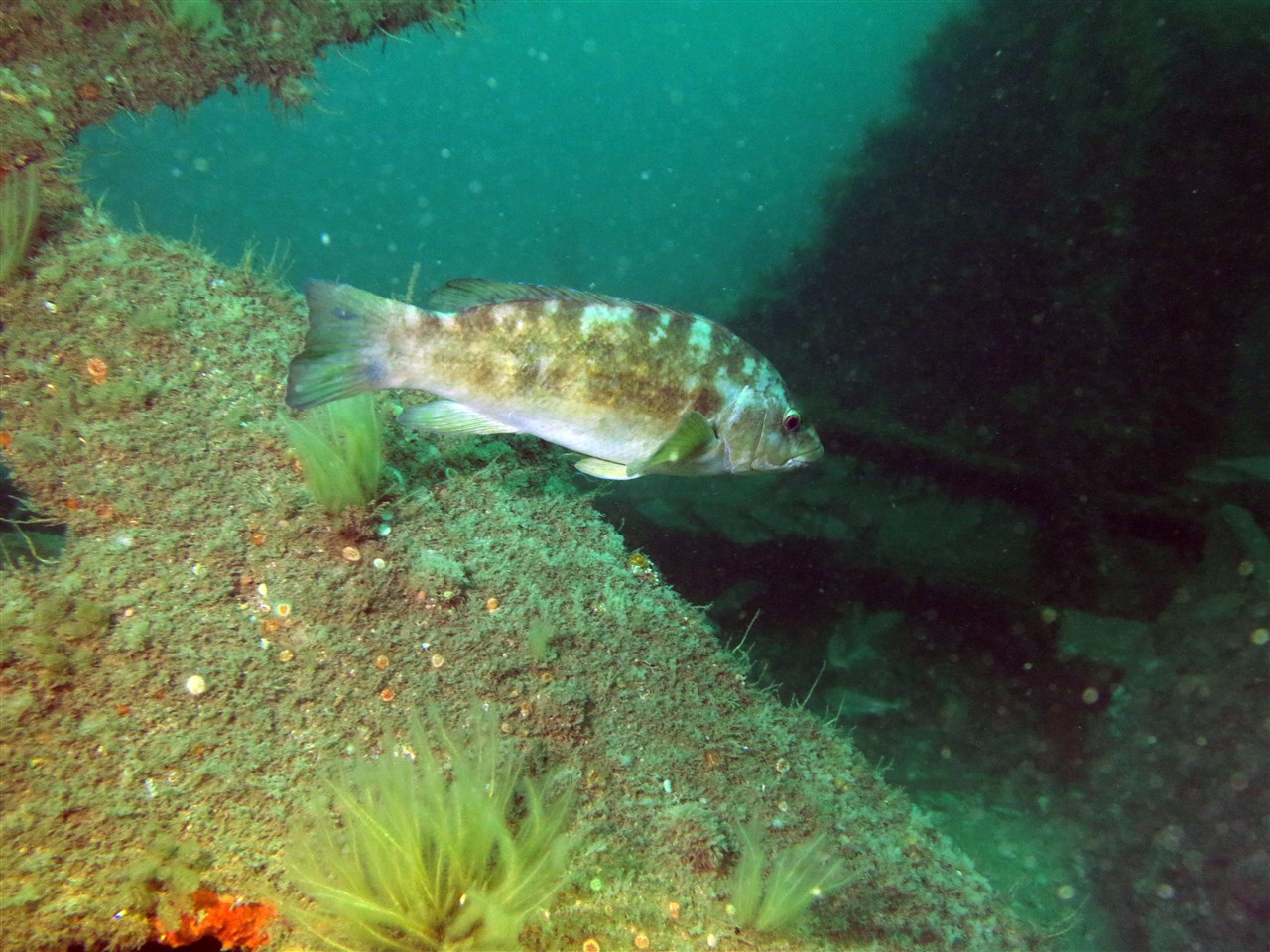
Wrasse
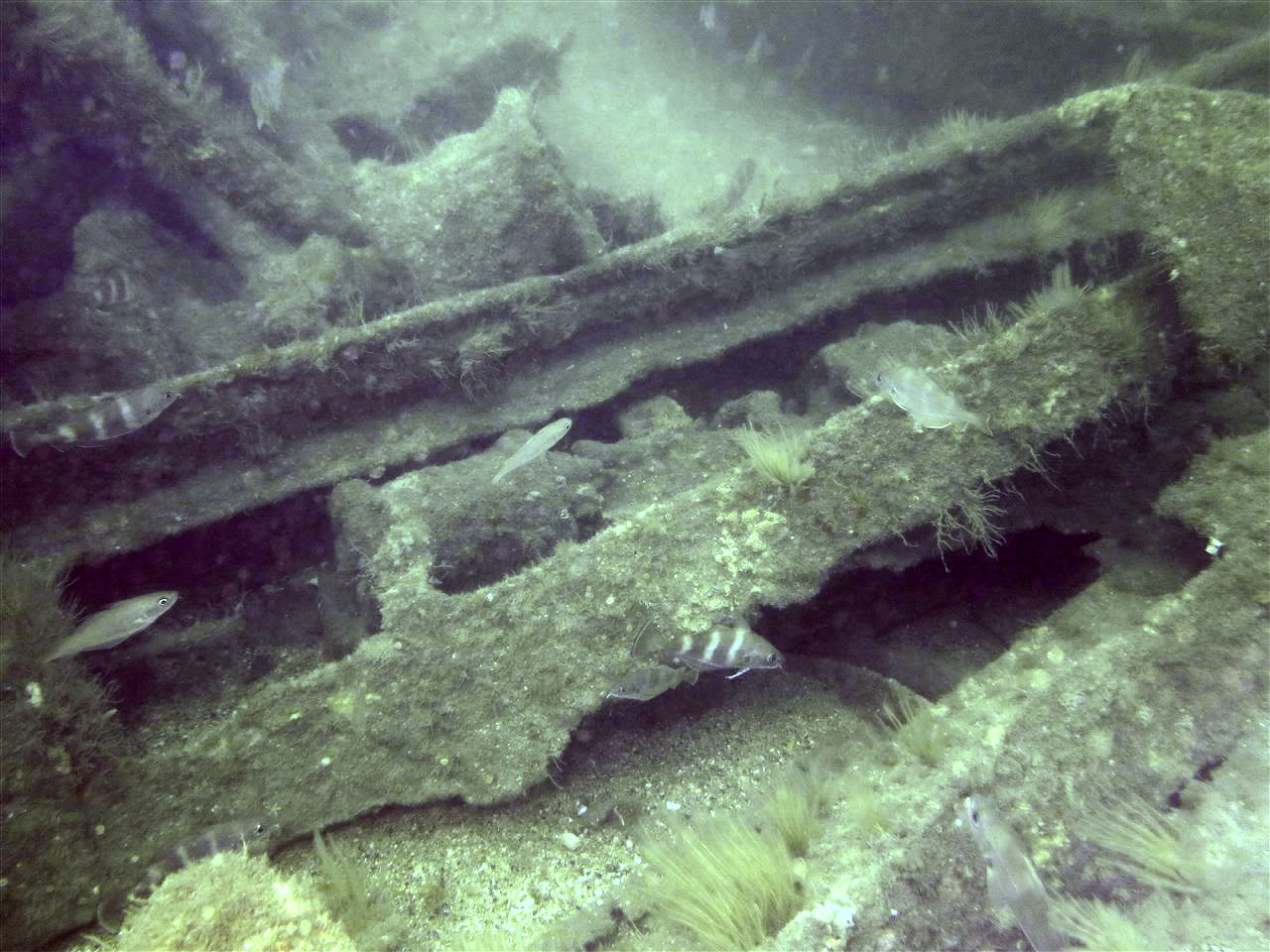
Bib galore
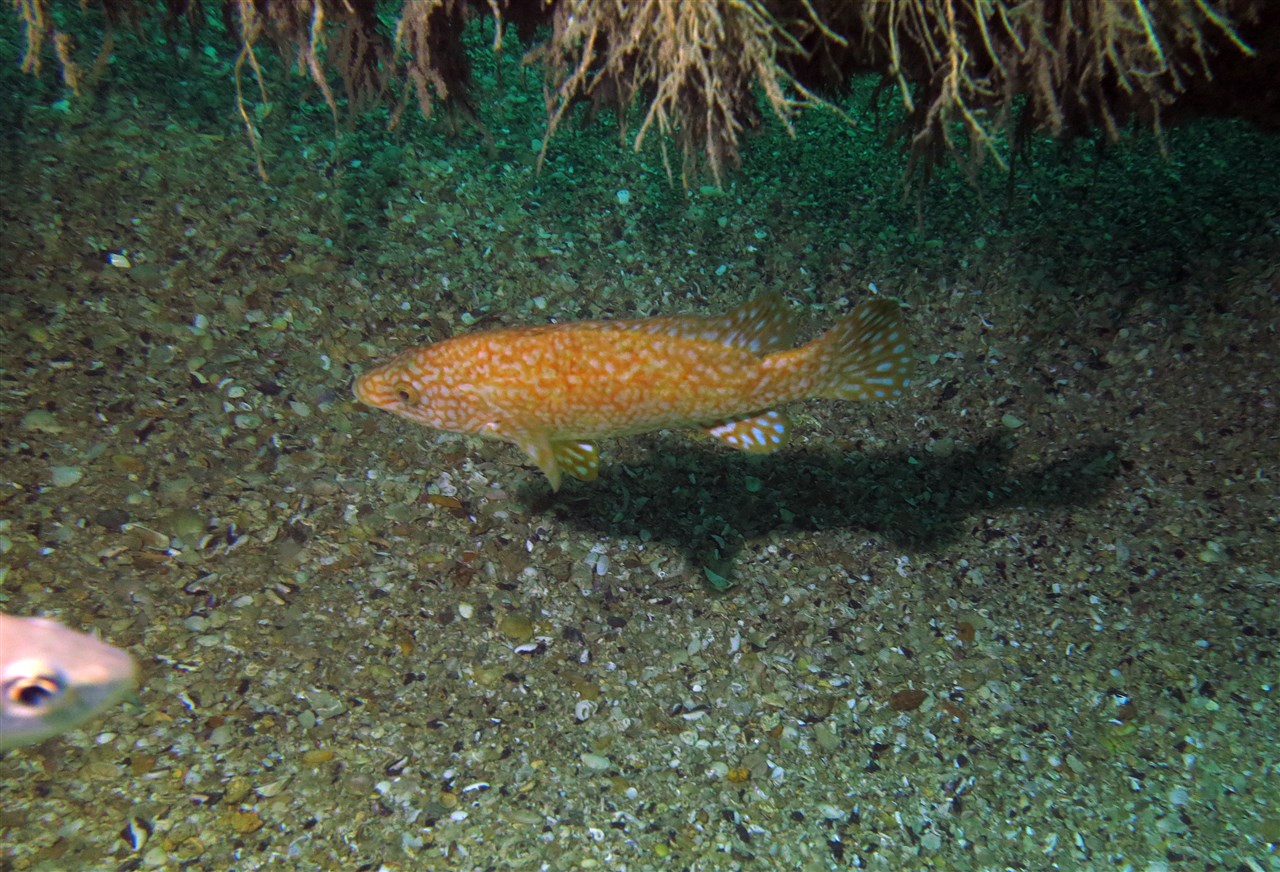
Colourful Ballen Wrasse
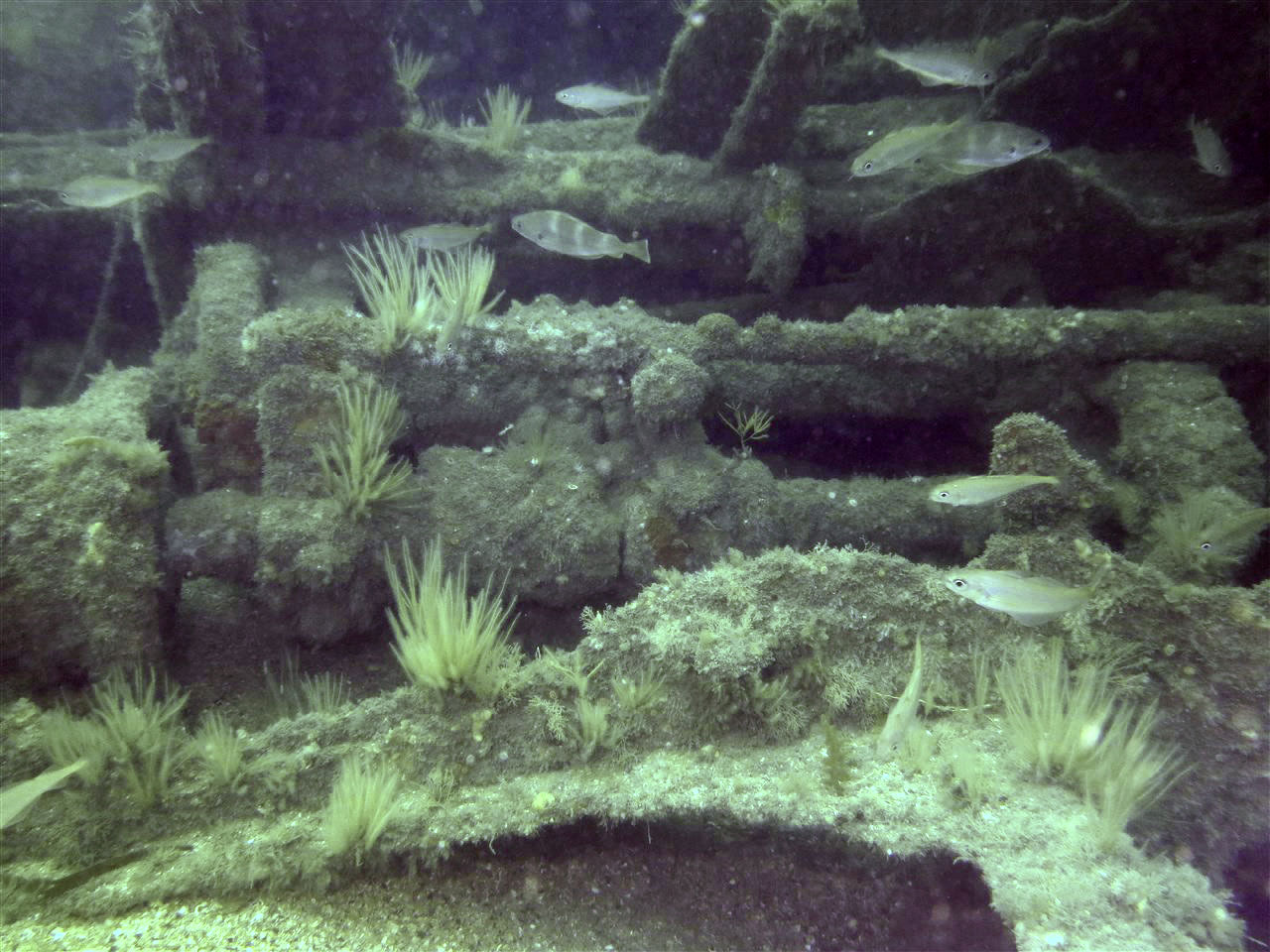
Machinery and Bib
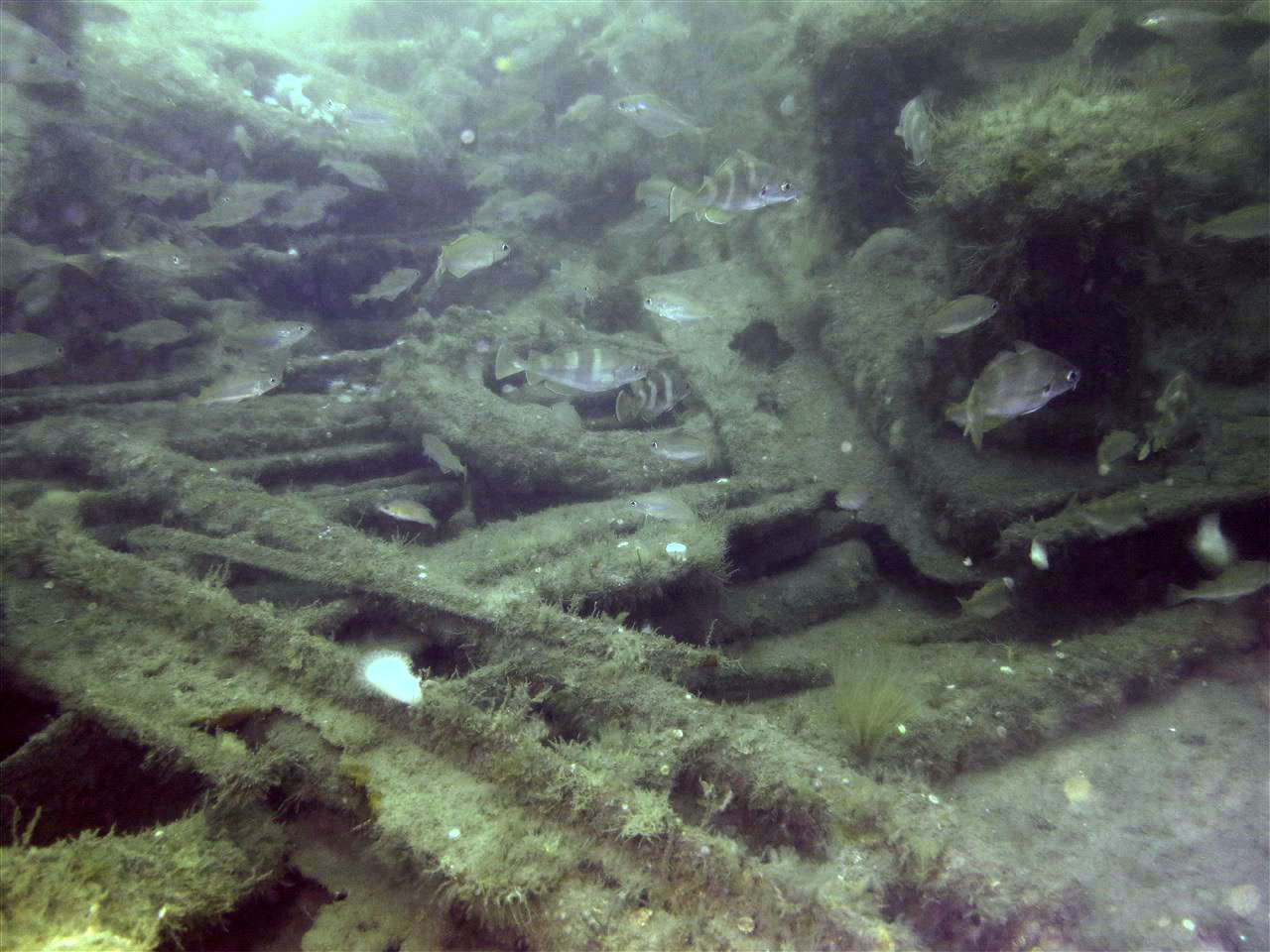
Trawling is almost impossible around a wreck, so fish are safe here and they know it.
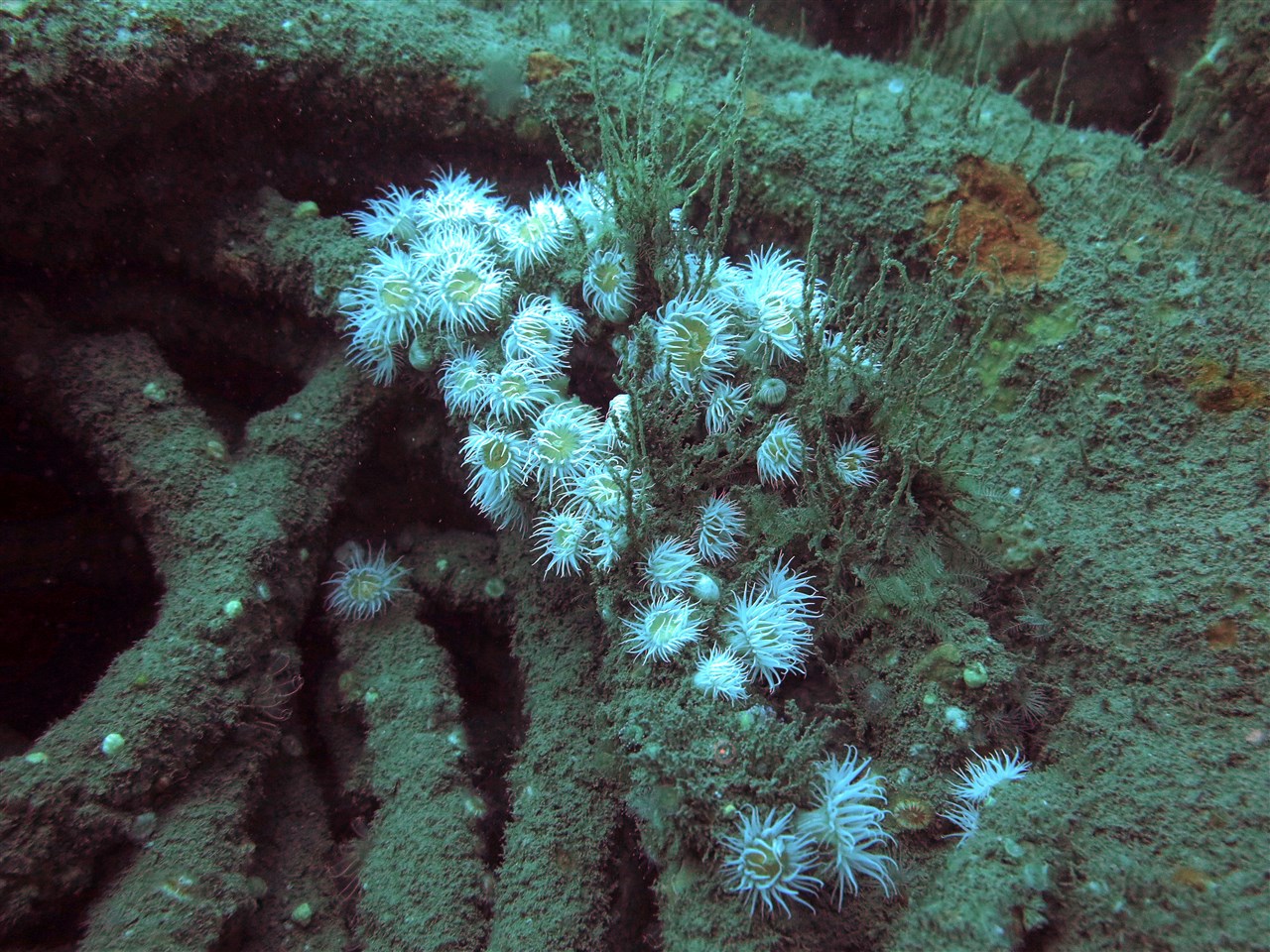
Fish and crusteceans aren't the only life on a wreck
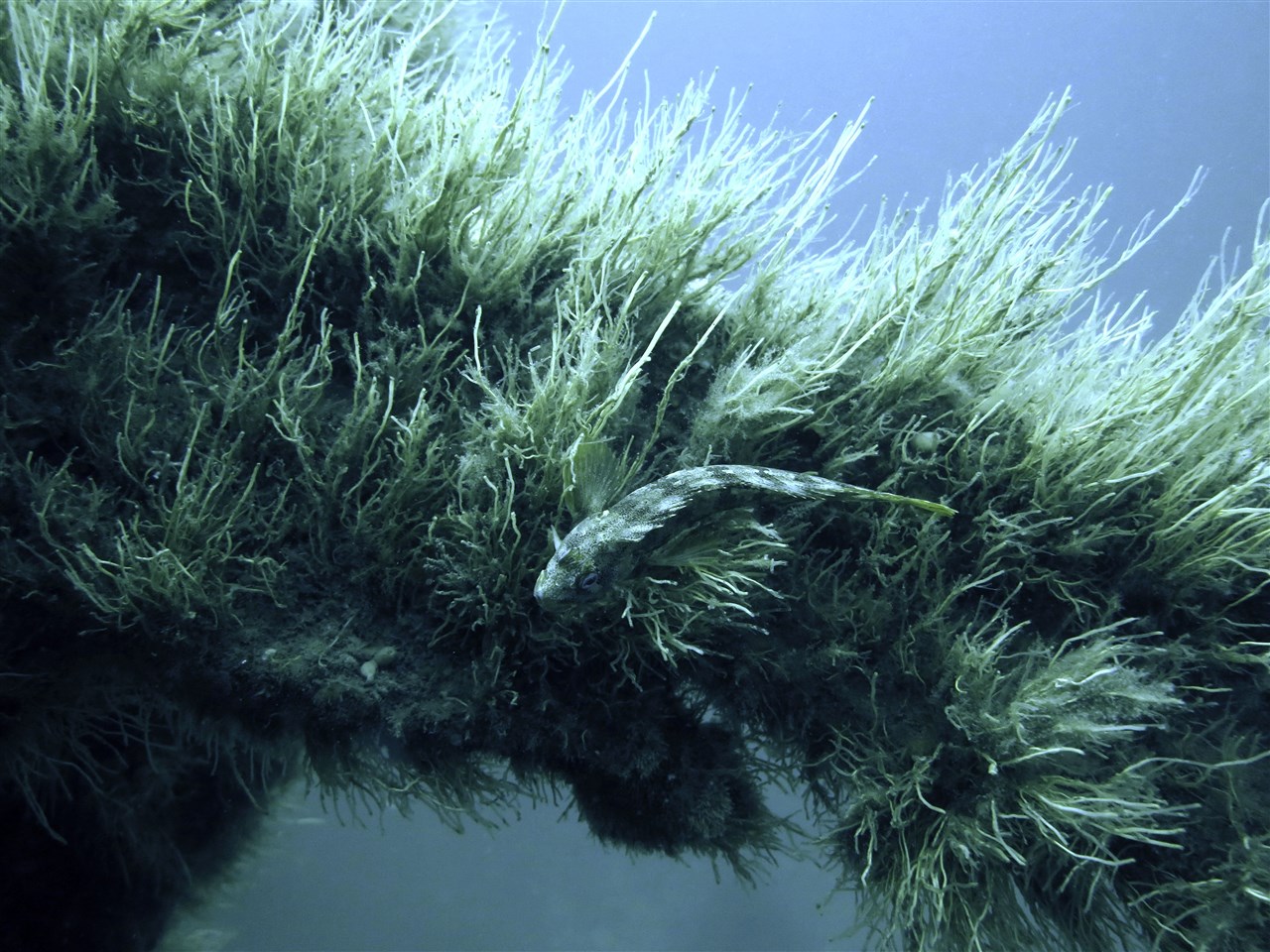
Blennie blends in well with the weed on the wreck
We moved through wreck, with an easy 10M (probably a bit more) vis throughout and loads of life to see.
We found ourselves on the stern, dropping down to the sea bed here, but found a strong current here that nearly swept us off the wreck.
We managed to work our way around where the prop and rudder once were and worked up the side of the hull and dropped back inside, finding our way through the large open areas with bulkhead structures often photographed by others and then past the engine and around and over the two large boilers.
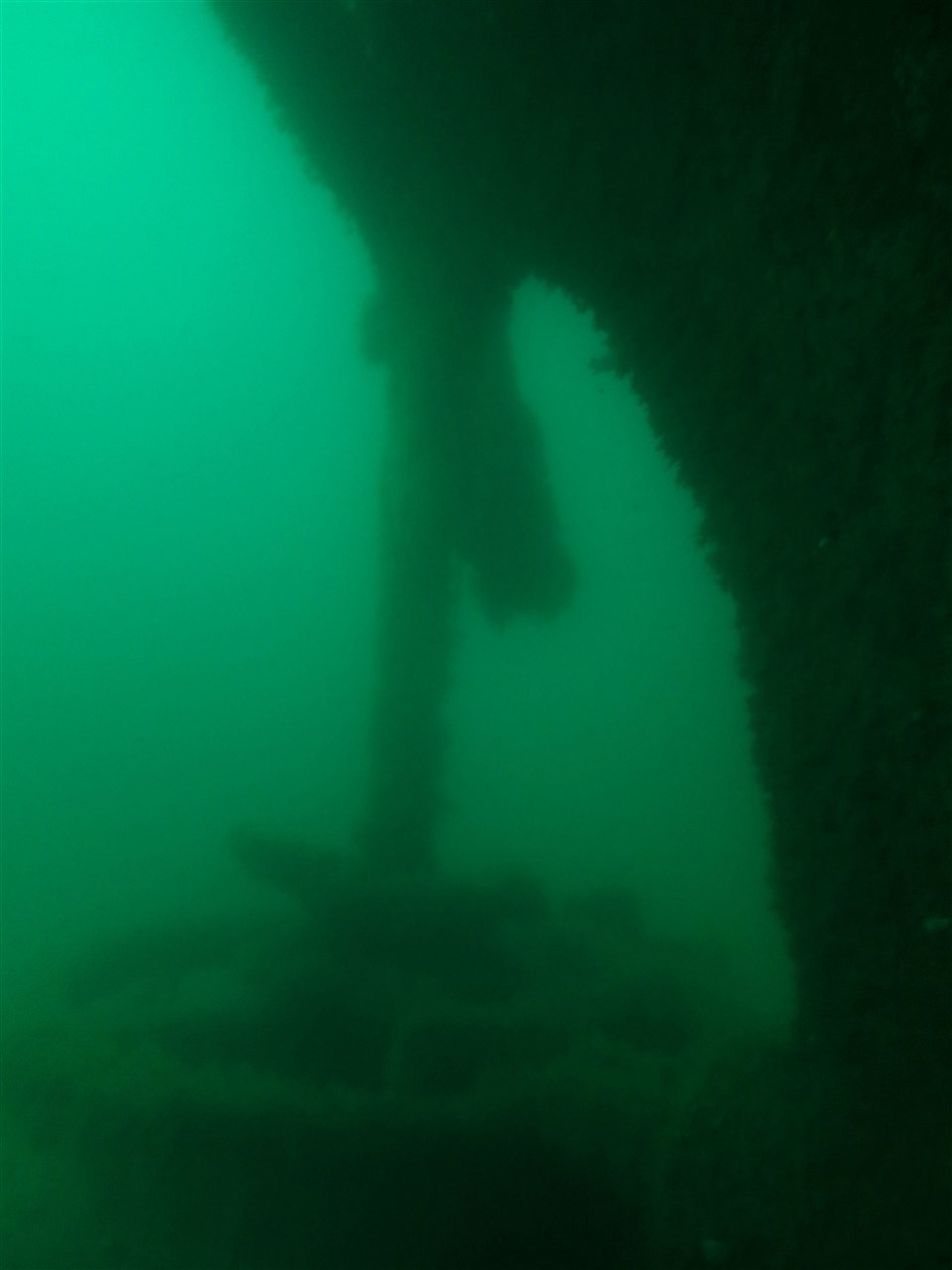
Looks like an anchor, but probably rudder post, at stern
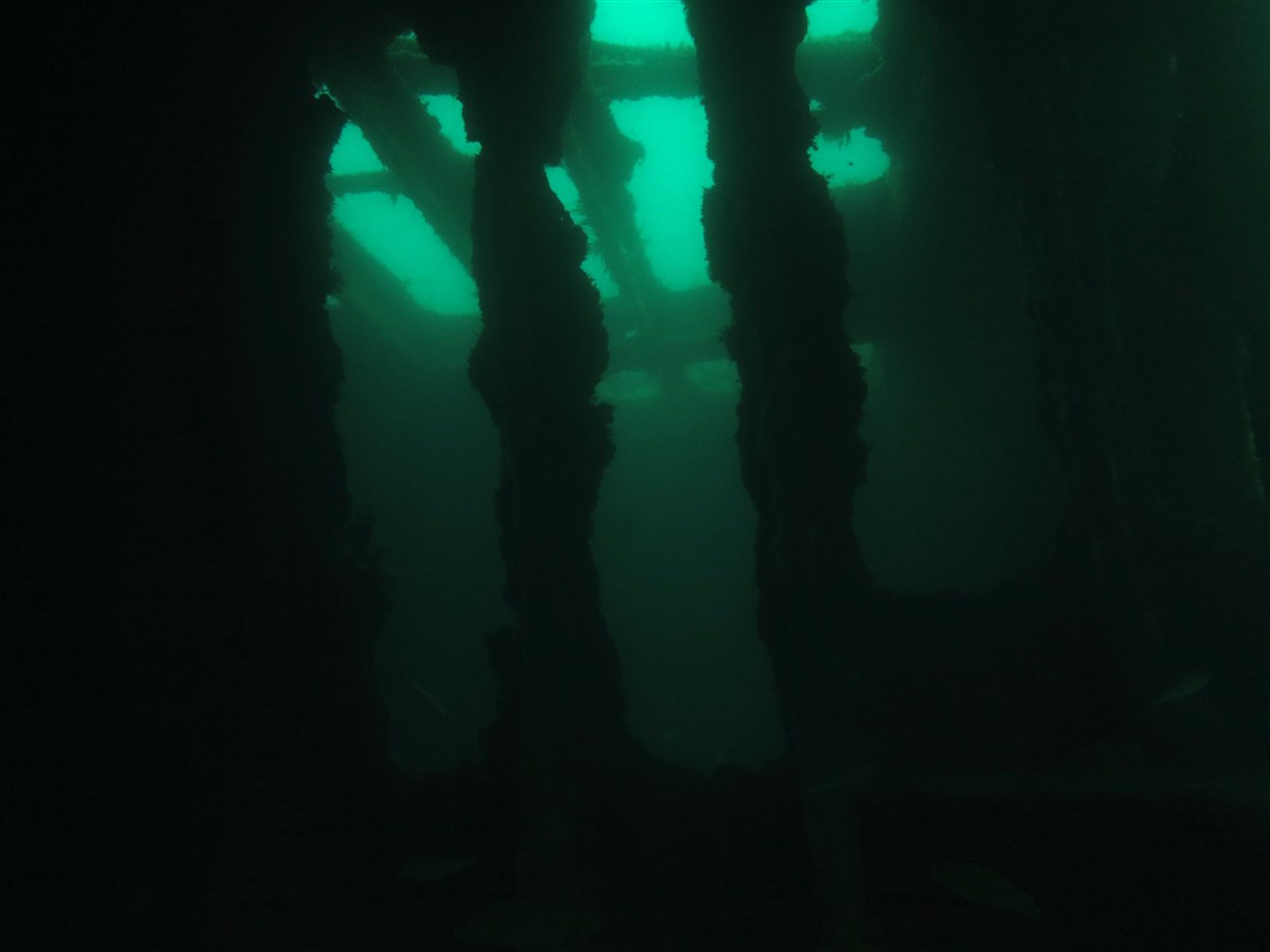
Ships skeleton makes for an atmospheric, but safe dive inside the wreck
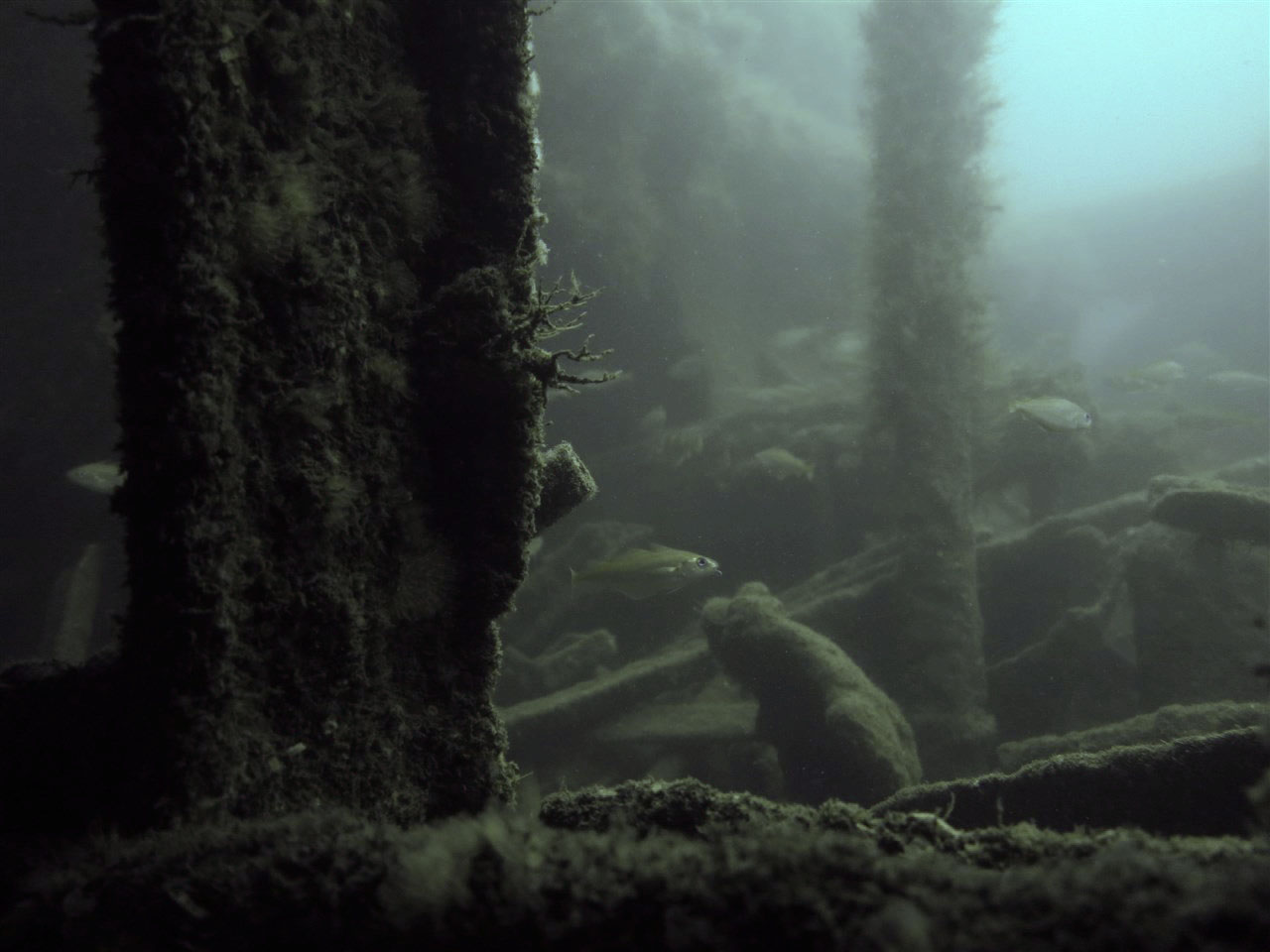
Fish cruise inside the wreck
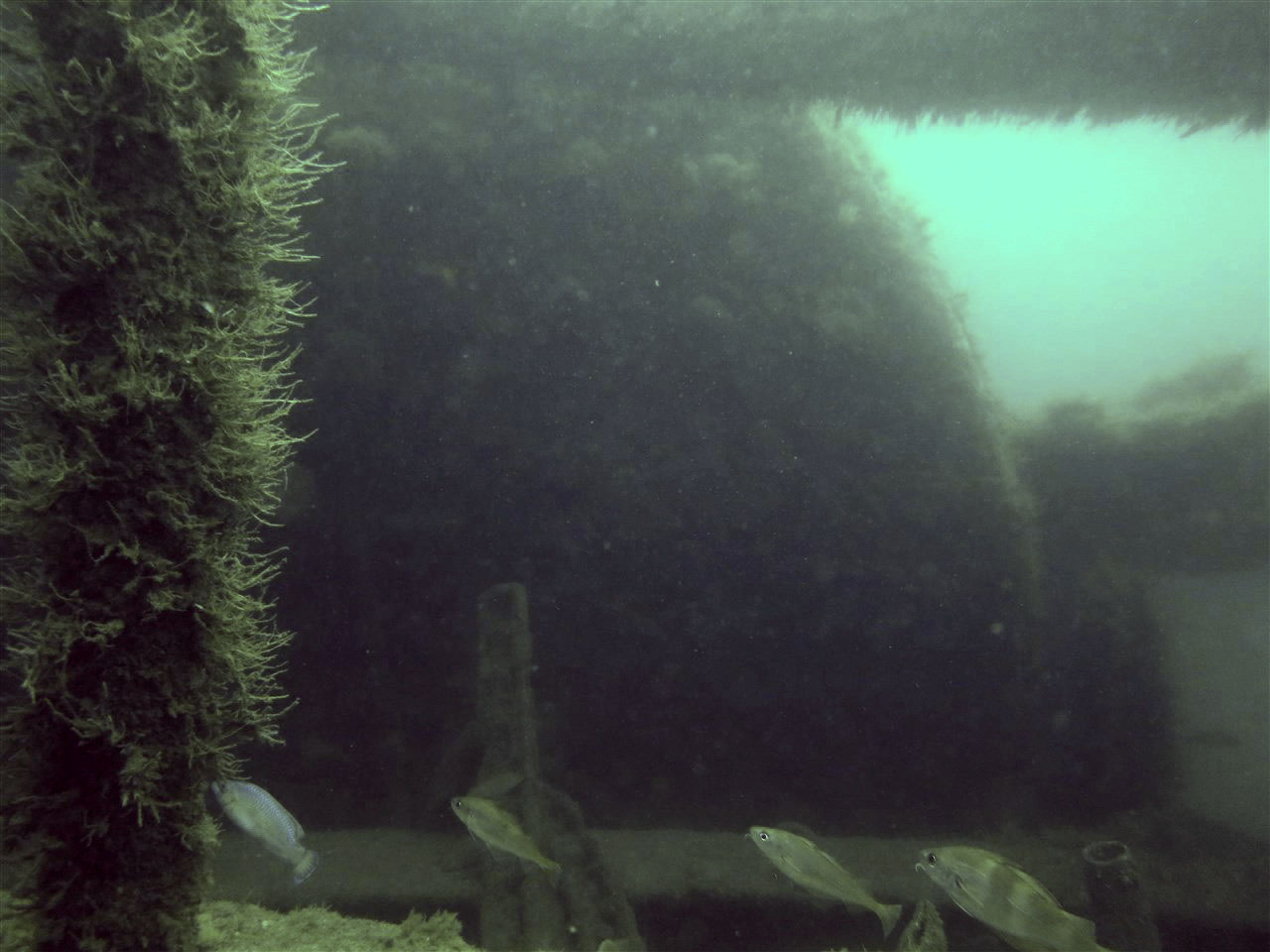
One of the boilers
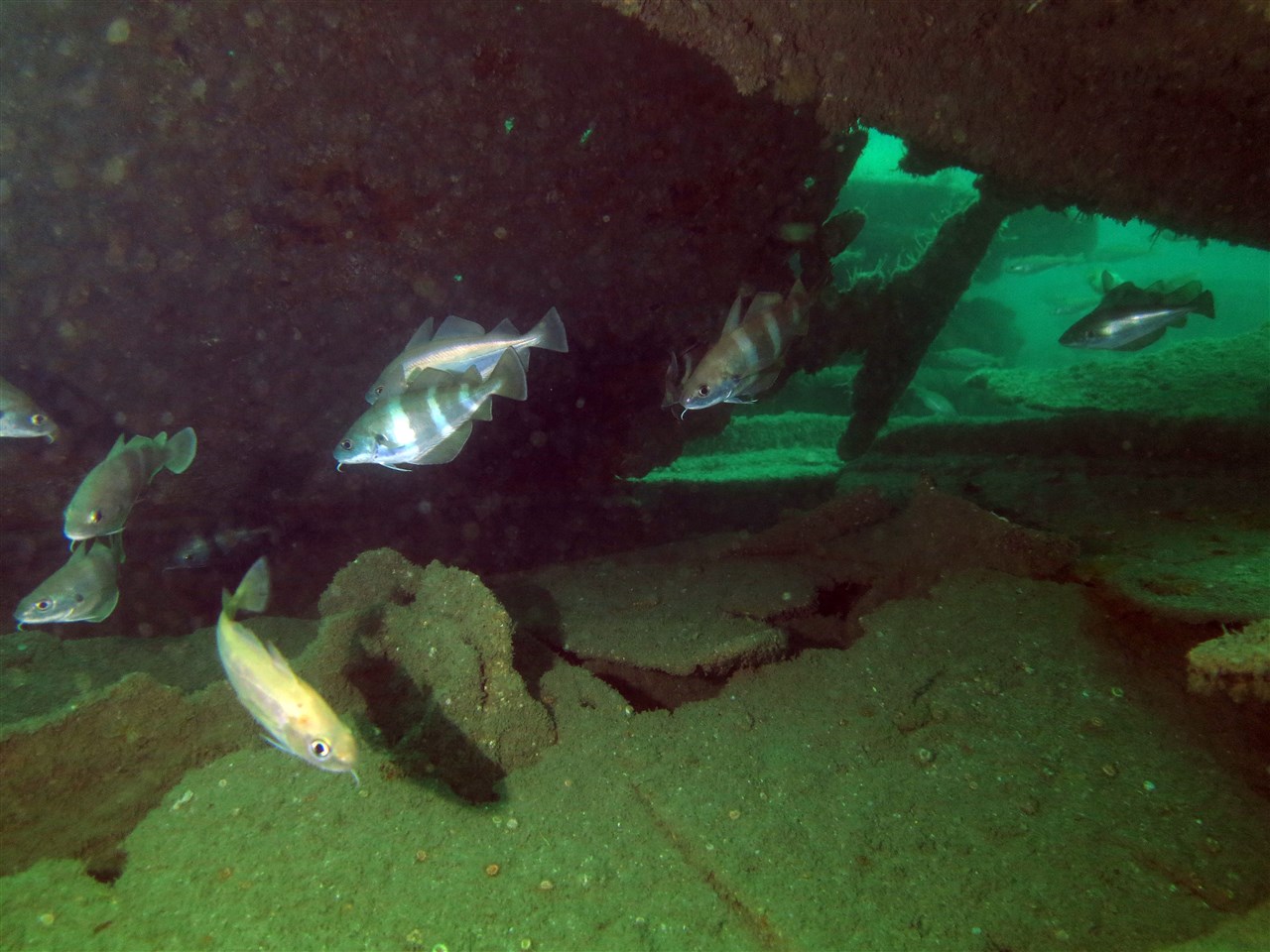
Under the boilers
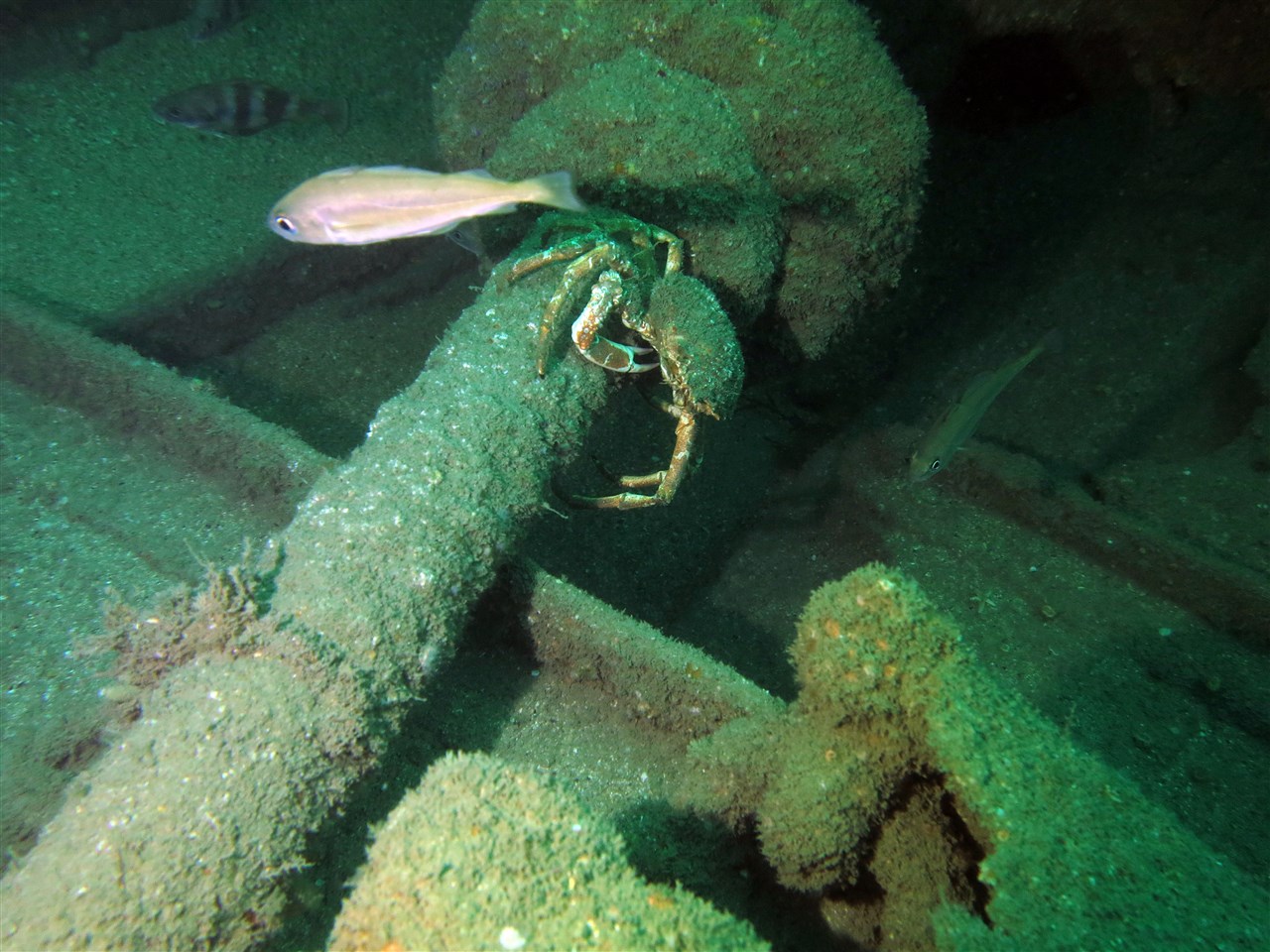
Spider Crab
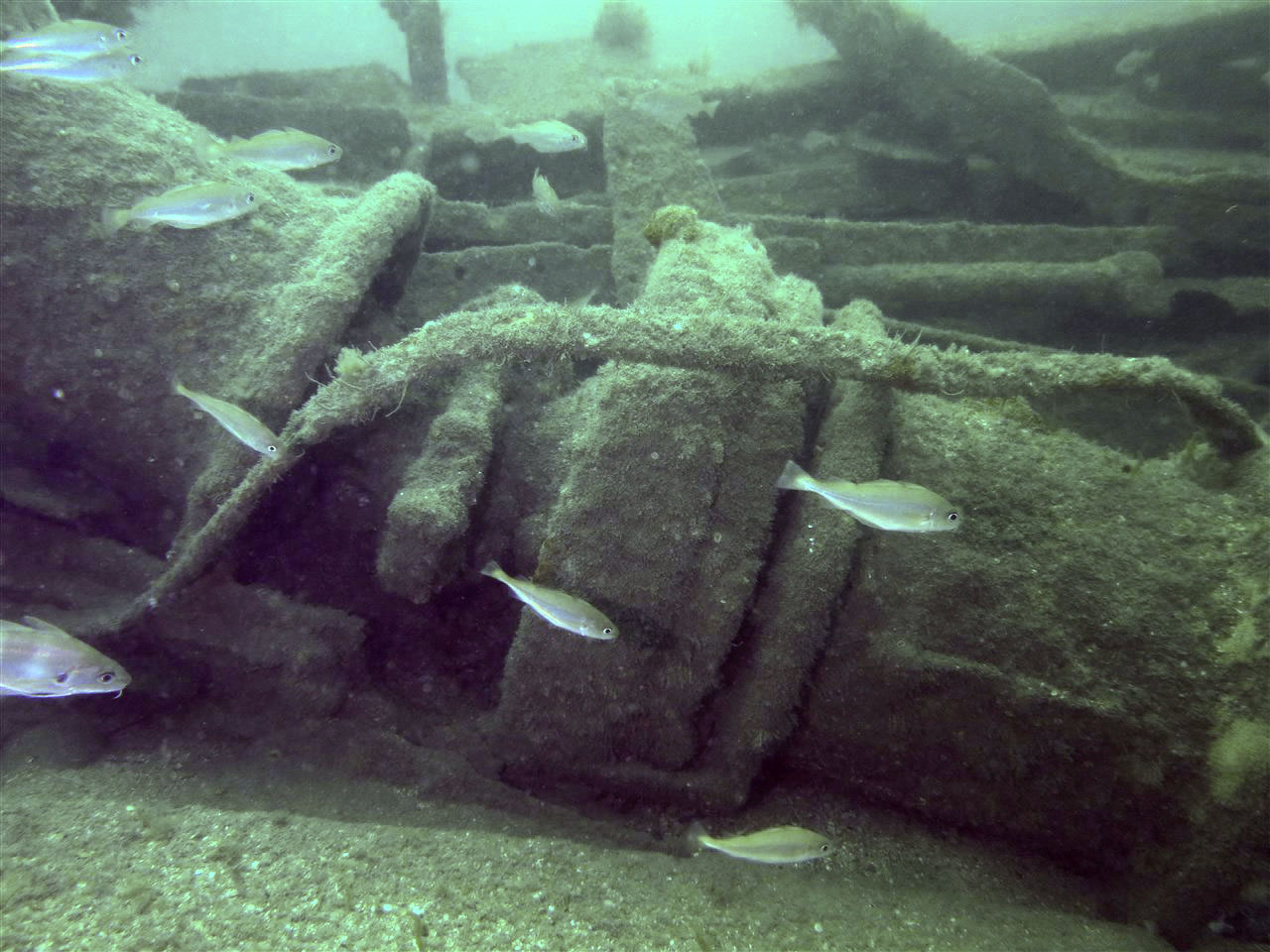
More machinery, more Bib
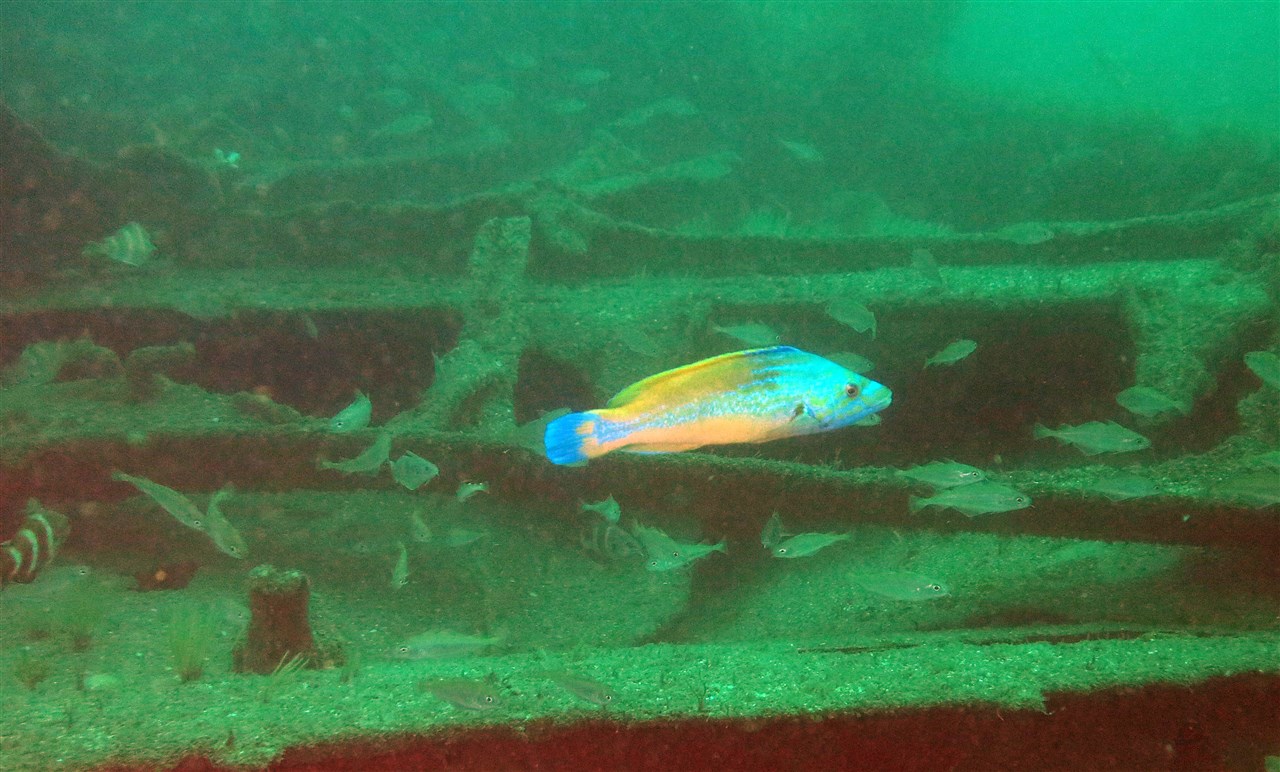
Lovely Cuckoo Wrasse
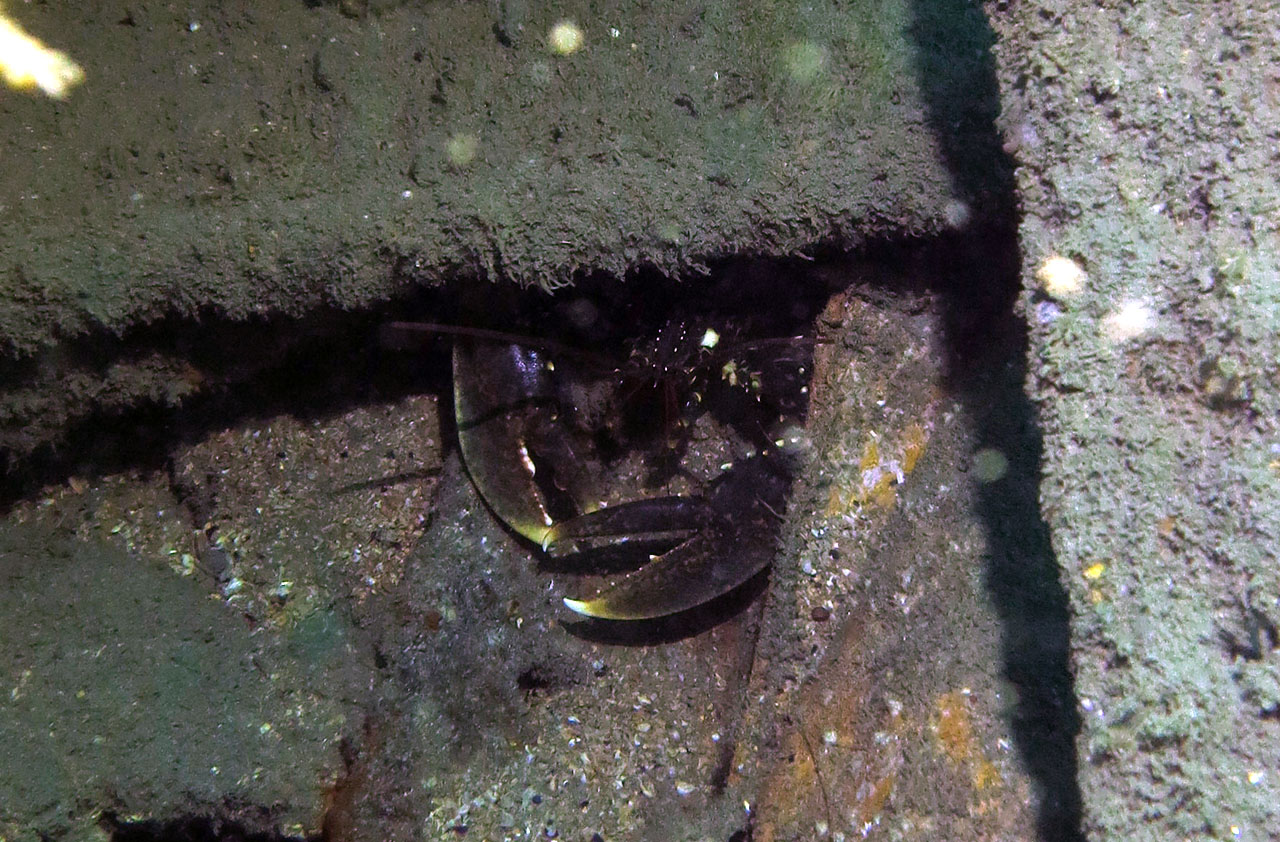
Lobster finds a home amongst the wreckage
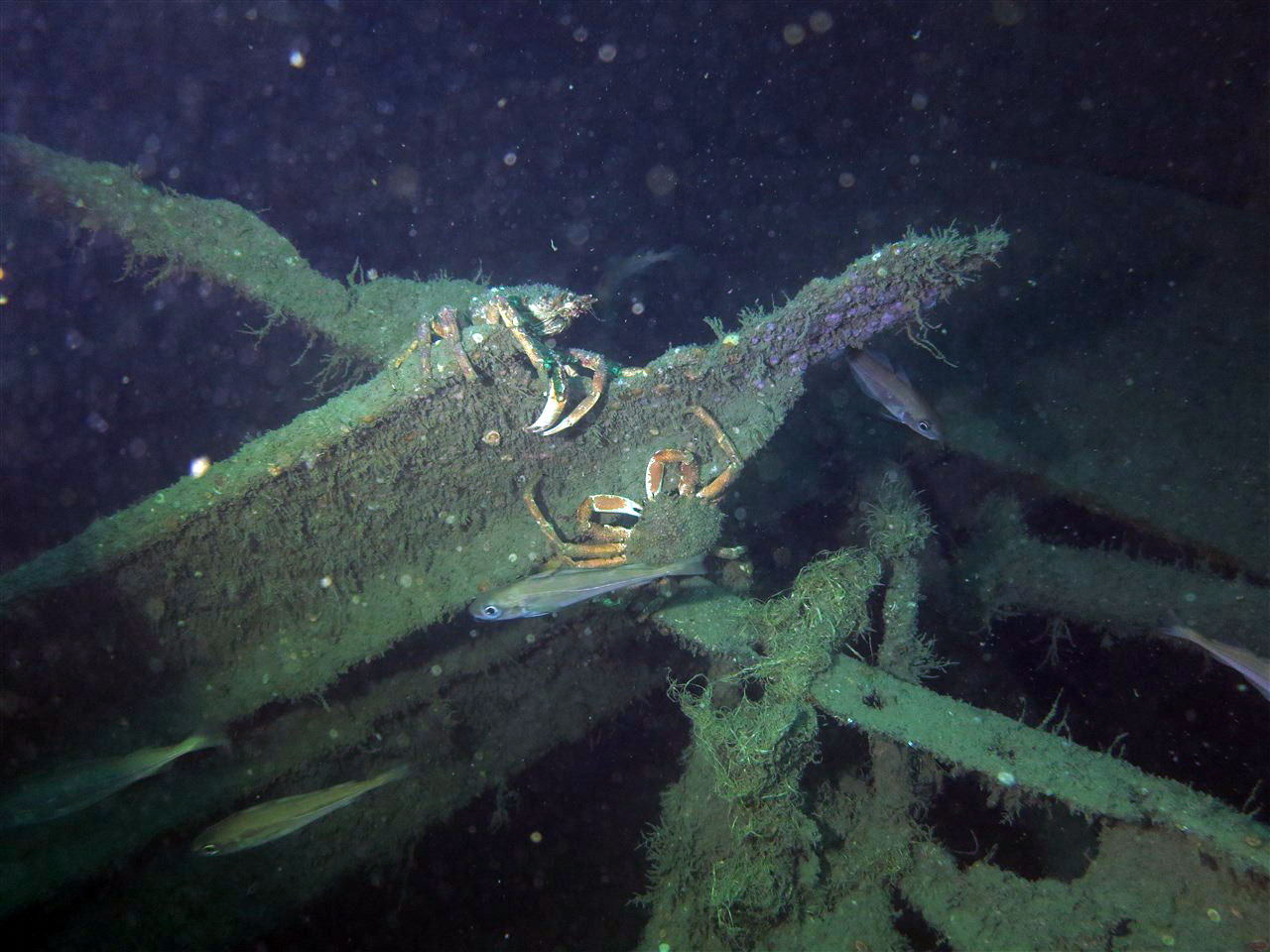
More Spider Crabs
After that, the wreck is quite open and collapsed until we reached the hull again as it formed the bow.
I peeked out around the bow side, but didn't swim out as I was worried about possible current and we were getting close to our planned 30 minute bottom time at this point.
To be honest, I was tempted to stay there longer and forego the final dive of the weekend (or see if any one had any spare gas and a whip!), so good was the vis and interesting the wreck, but John indicated I should pop the DSMB, so I went along with his suggestion (and our agreed plan) and deployed it.
We both had taken O2 to decompress on, with 50% for me, which I switched to at around 20M, having incurred around 5 minutes deco at 6M.
This had been one of the very best dived I've done in the UK and I will dive it again, weather and tides permitting!
After more warm pasties and tea and motoring back towards Plymouth for around an hour, we reached the final dive site of the weekend, Hillsea Point Rock (I think this is sometimes referred to as 'Fairyland' as well).
This is a pinnacle that drops done to 30M or so and features rocky crevasses.
I dropped in with John and descended down the side of the pinnacle, through ravines.
On the descent I saw and photographed a bright blue jellyfish.
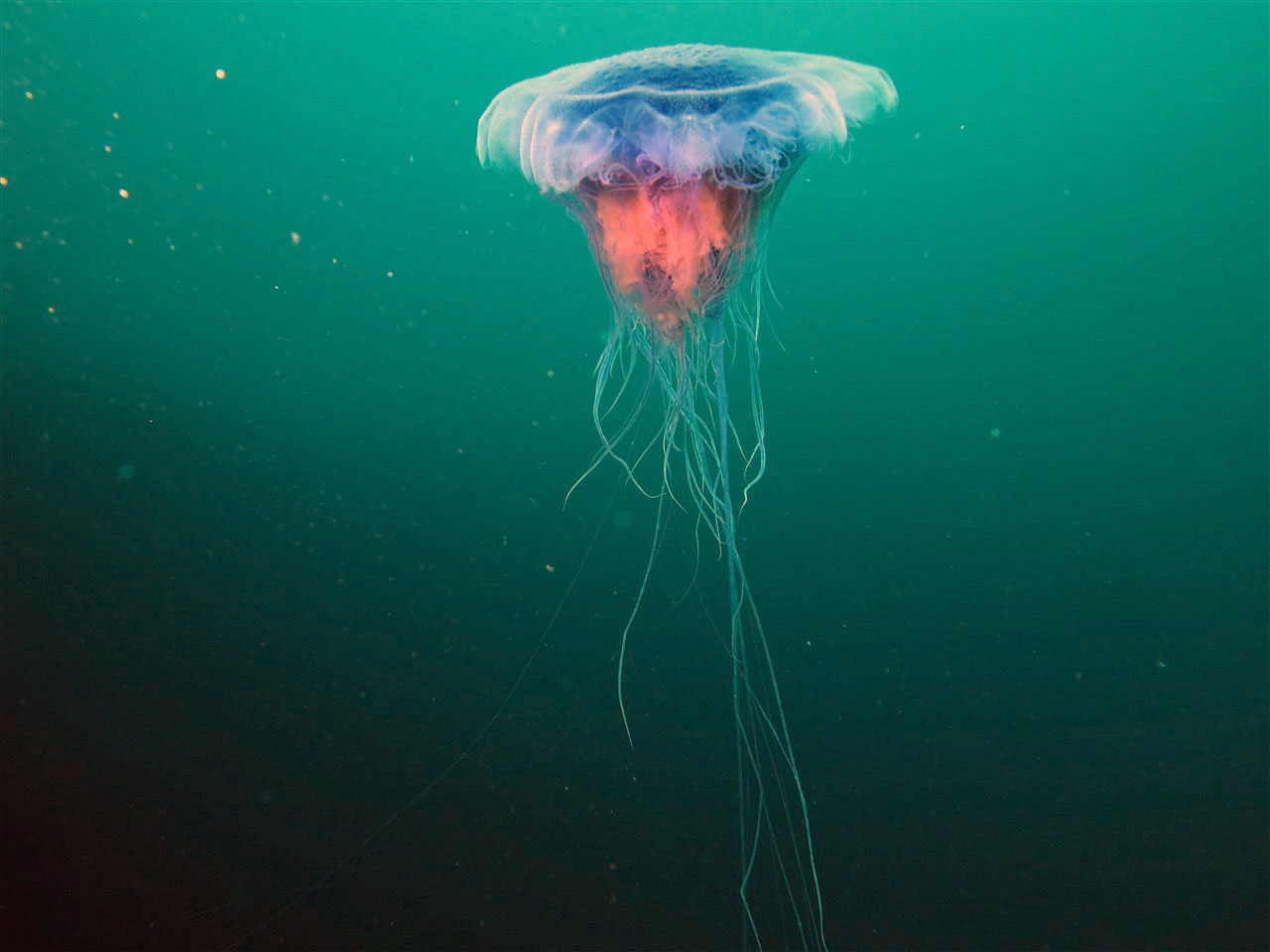
Colourful Jellyfish got my attention!
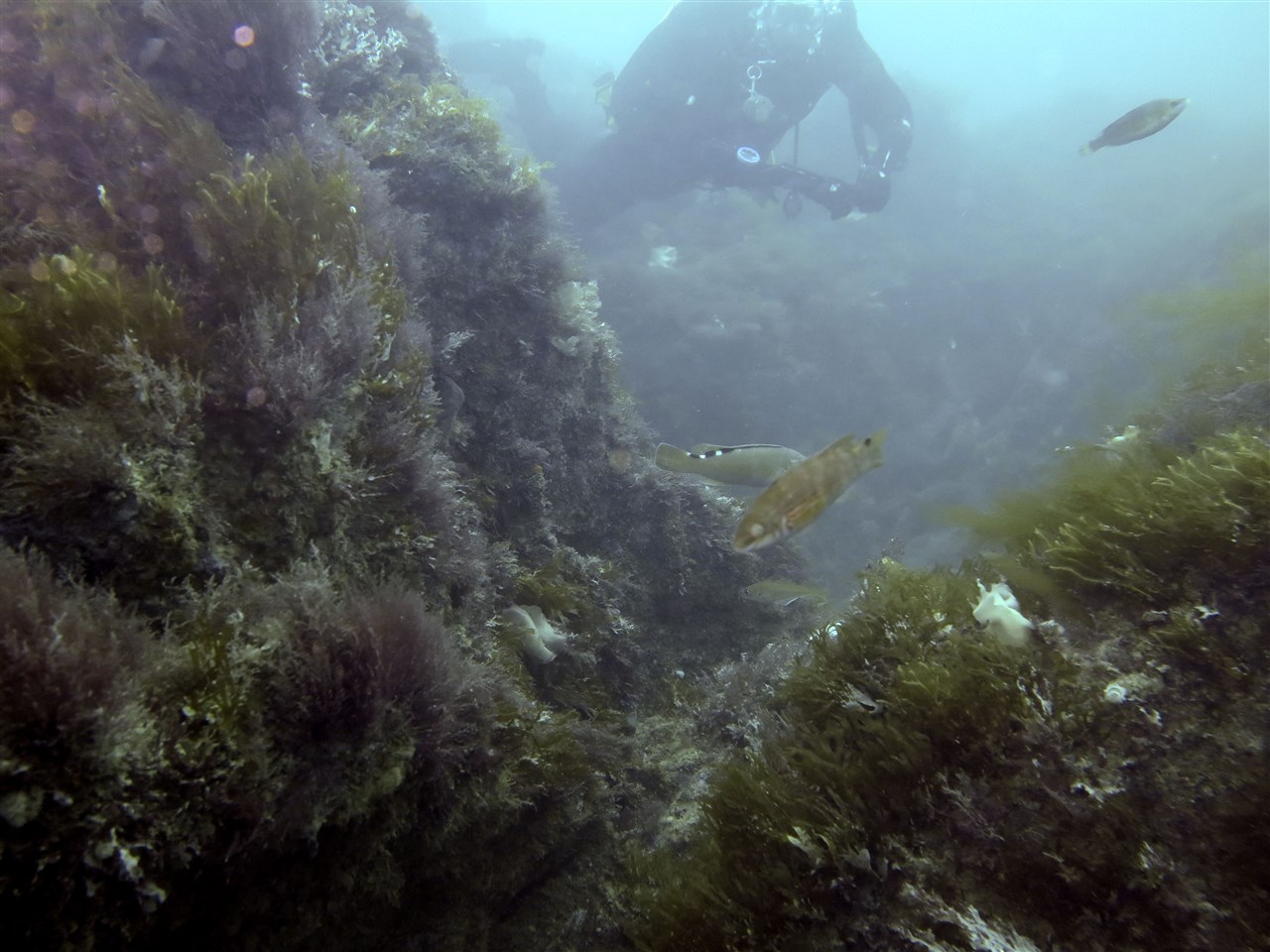
John explores the gullies
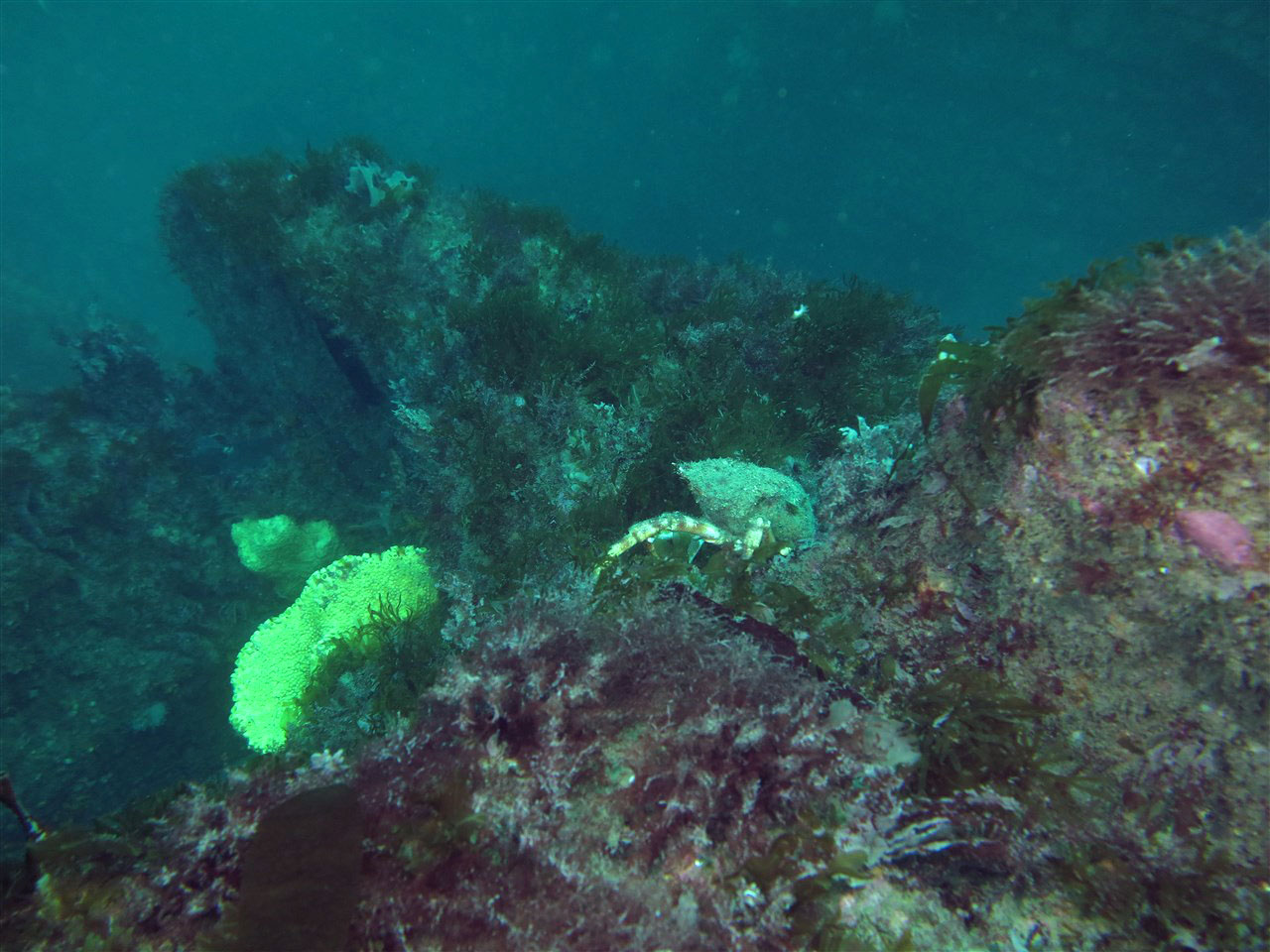
Sponges and Crab
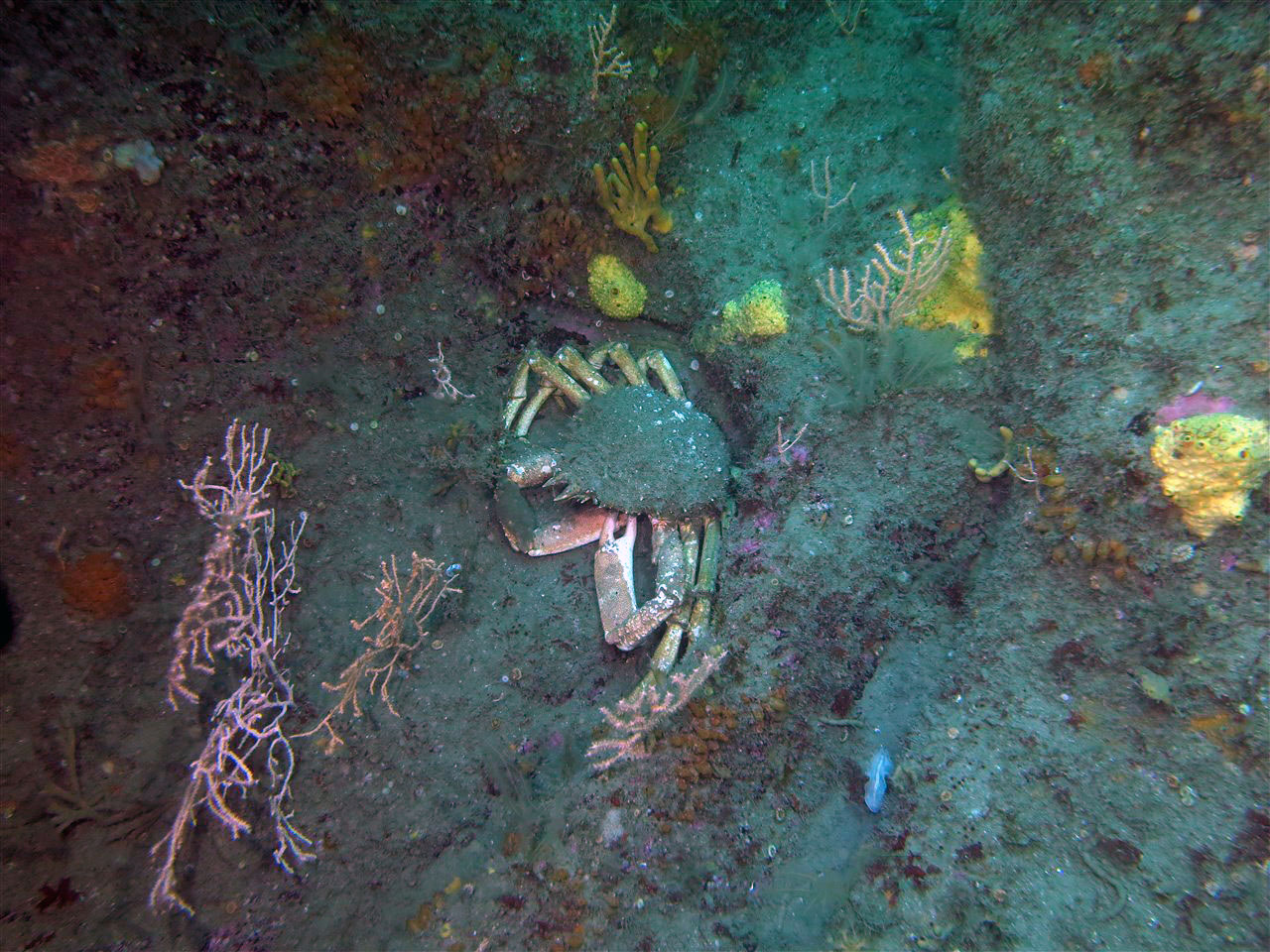
Big Spider Crab
We saw a small Conger hiding in a crack in the rock shortly into the dive, although others had stirred up a lot of sand, so couldn't photograph it.
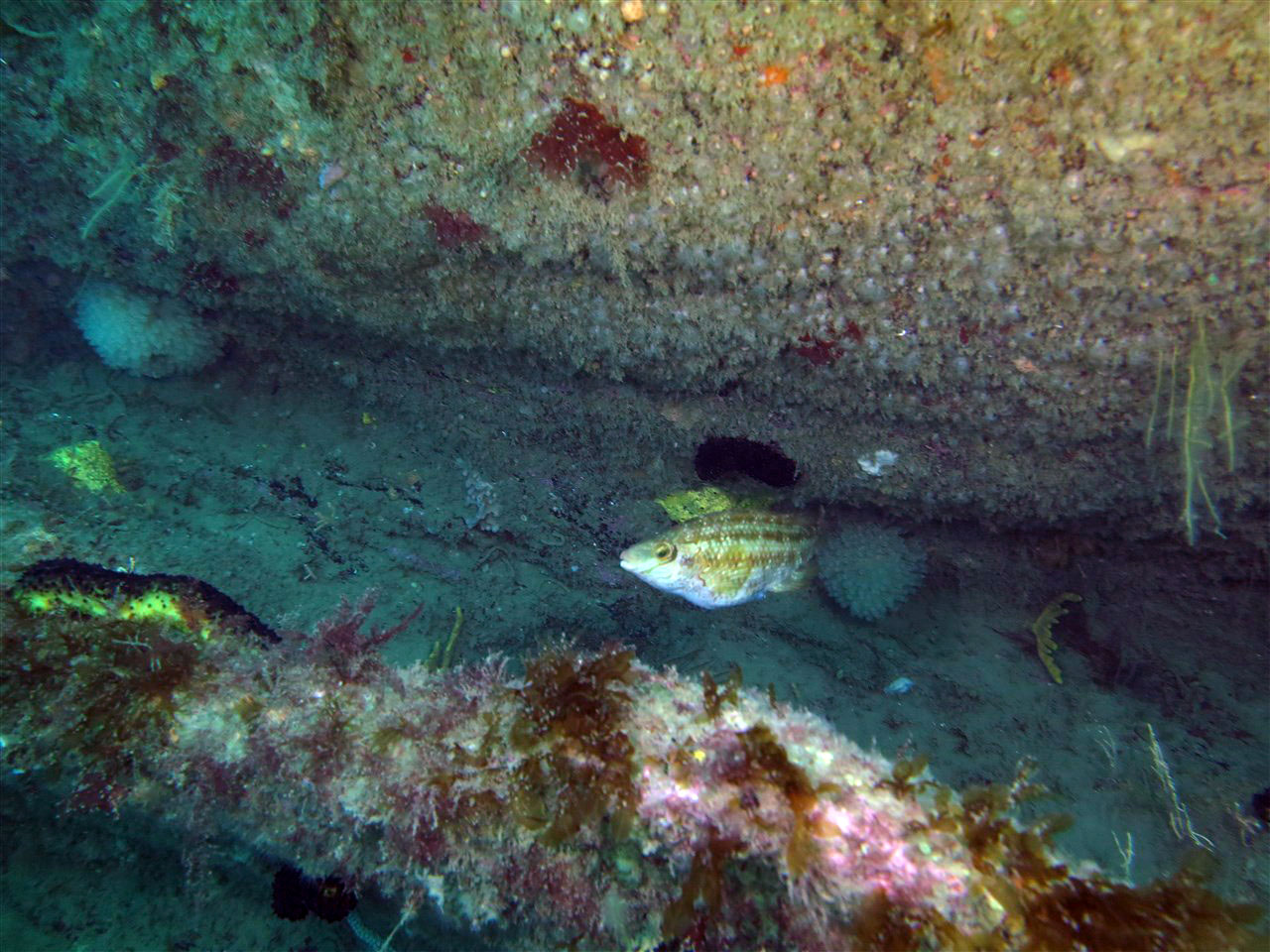
Fish, sea cucmbers and sponges
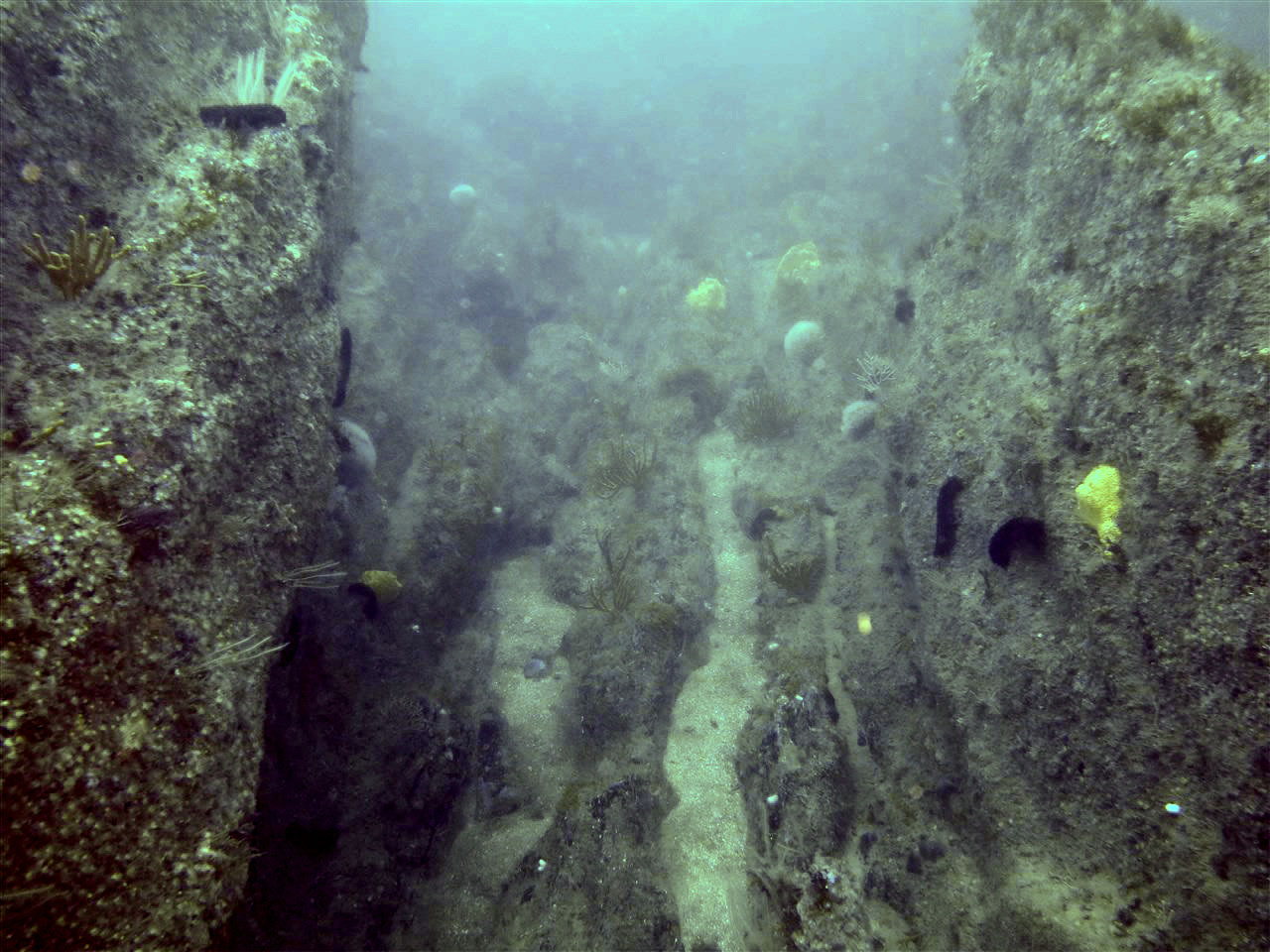
Deep rock gullies a feature of this site
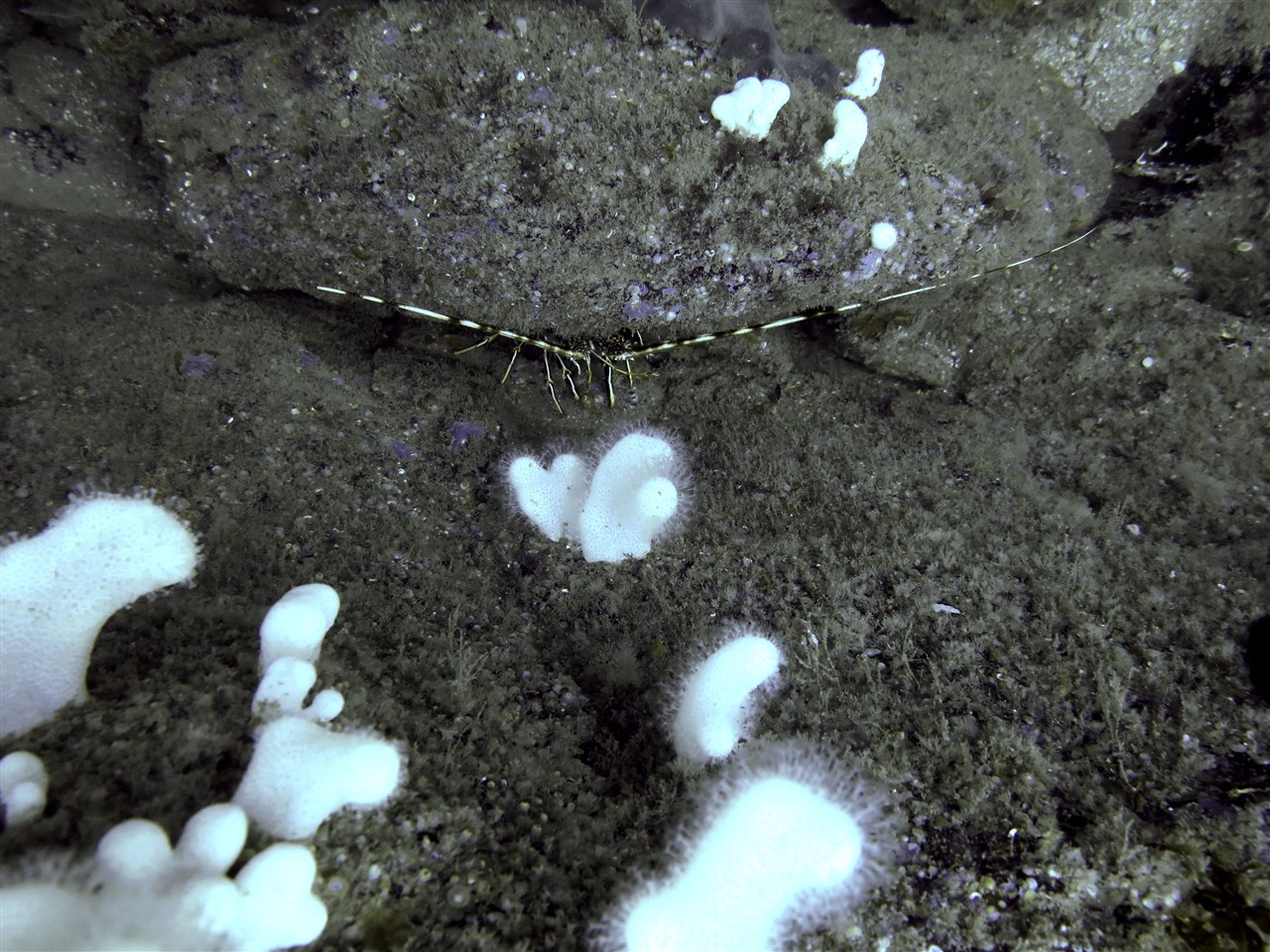
Spiny Lobster (Crayfish) looks out of his hideaway
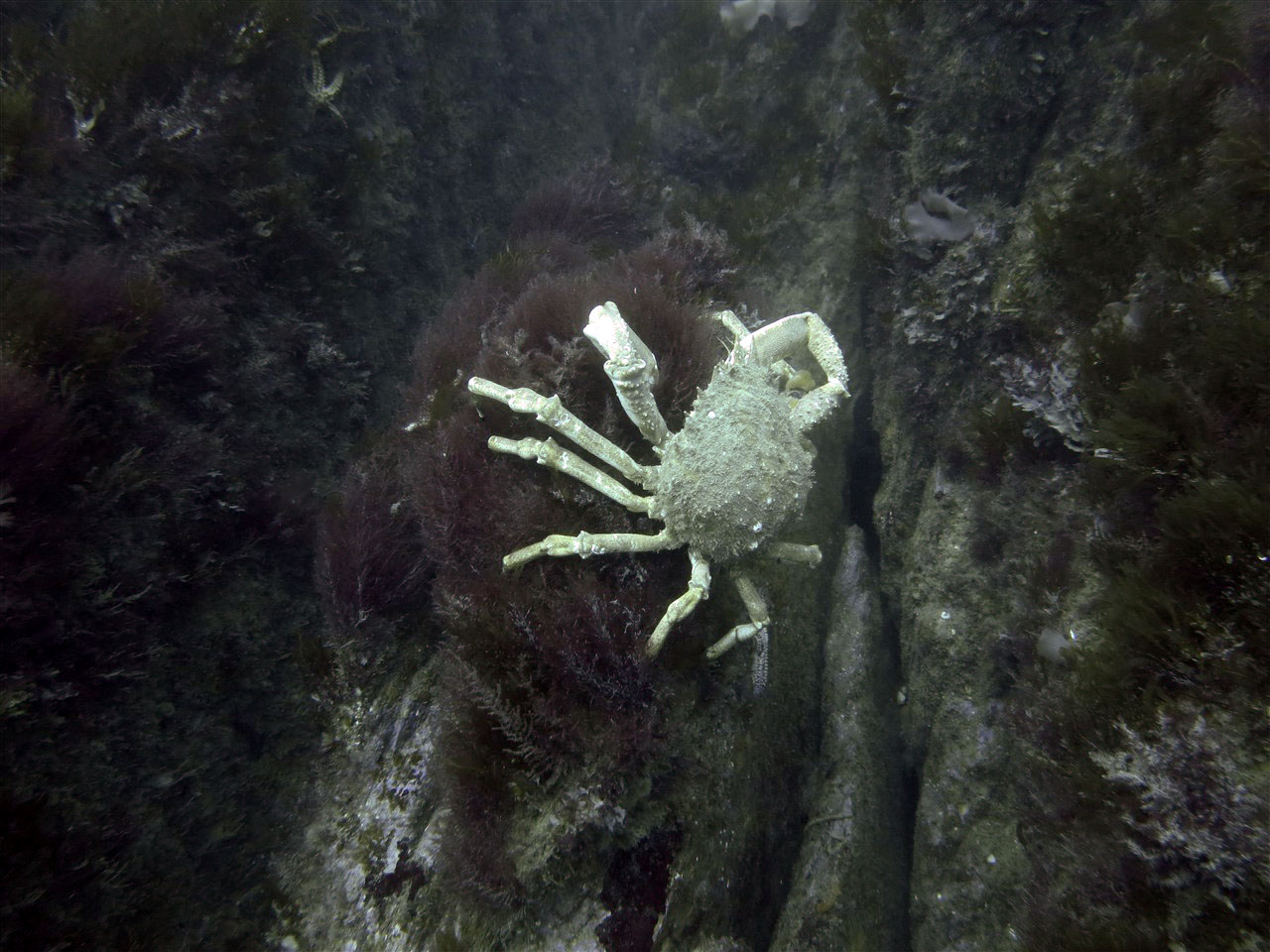
Another big Spider crab
Generally, we drifted around, spotting lots of fish and a spiny lobster.
We both had limited gas after our first dive and went surprisingly deep on this dive (27M), so it was relatively short (33 minutes), but it was an enjoyable reef dive after 3 wreck sites and a relaxing way to end the excellent weekend's diving.
I didn't fancy a slow, stressful drive home, so stayed another night at the Barbican Reach, enjoying one of Rob's excellent breakfasts on Monday morning before making my way home.
As it turned out, it took me as long as it had taken some of the others on Sunday, but at least I was refreshed for the drive.
So, another great dive weekend in Plymouth and a stand out dive site in the form of the Maine.
Wraysbury
The weekend after Plymouth a lot of the club went to Porthkerris, but I didn't fancy two weekends driving that far in a row, so I didn't go - As it turned out they only had one day's diving as the weather turned too rough on the Sunday.
Club member Dave Price hadn't dived for a while, but had a new dry suit to try out and gear to check, so he and I made a trip to Wraysbury.
We got separated in murk a couple of times, but vis was surprisingly good in places, especially around the Taxi, the lifeboat and the boat graveyard.
We found the plane and it was nice to see loads of young Perch in the top of the rear of this section, after seeing virtually no life on my last dive here.
There were lots of crayfish around, too and some larger Perch, so it seemed my fears of a problem there were unfounded.
The water temperature was a very comfortable 18/19C above 7m, but noticeably colder below that.
It was a good little bonus dive as I hadn't expected to dive that weekend.
More RHIB Diving
A couple of weeks later, 4 of us were diving off the club RHIB again, in Portland.
The day started wet and overcast, certainly not the sort of weather you hope for in July.
We left early and arrived about 8, fitting the auxillary outboard, which had had a service and generally preparing the boat.
Our first dive was on the Binnendijk wreck, which I had dived 2 or 3 times before.
Where we dropped the shot was on a different part of the wreck to previous dives, I don't think I recognised a single part!
Dave Price and I dropped in directly on some wreckage and swam around in a fairly random pattern.
At one point we reached what look liked the bow post sticking up from the sea bed. Just behind that were 6 vertical 'posts' (for want of a better word) in a square.
We also found a large squarish box structure with rounded edges, but it didn't look like a traditional boiler.
Loads of life, Blennies, Bib, Wrasse, Spider and Edible Crabs, lots of Lobsters, a huge Spiney Lobster and a few big Congers (and some smaller ones).
Really enjoyable dive, although vis was 'snotty', probably around 3-5M.
We were all impressed by just how big the wreck is, as we all saw some we had never seen before.
Oddly, although both on air, I had 5 minutes deco at 6m, but Dave had nothing!
We completed my deco stop without issue (except I was getting a little cold, having forgotten my thermal top) and rejoined boat.
Typically, I'd figured the weather would be too overcast for decent photographs, so didn't take my camera!
Dawn and Julian then dived it and also had a great dive, finding 3 boilers at one point.
We motored back to Castletown where I enjoyed a lovely crispy bacon roll at the Aqua and we filled our cylinders for a drift dive in the afternoon.
Dave and I went in first and had a fast (2 knots, according to Julian on the boat) drift dive down Portland Bill.
Vis was quite murky 2-3M and too fast to stop and admire the scenery much.
I forgot my computer after lunch, so I did the dive on my watch and depth gauge, as I spotted it as soon as we reached the seabed - Old Skool or what!
Average depth was probably close to 12M, with maximum depth being around 20M.
I spotted quite a few big Wrasse and one good sized lobster, plus a few crabs, but it was very hard to stop and look in the current.
At one point I lost sight of Dave, so grabbed a rock and turned around to look into the current. You could see the sediment rushing by, but it was fairly easy to hang on in that position. In a few moments, Dave appeared about of the gloom and we carried on.
Towards the end of the dive, Dave and I got separated again and after waiting a short while, I decided to surface, but it seemed to take an age for me to wind in my spool as there was far more than 12M (depth at this point) line deployed and by the time I surfaced Dave was already dekitted and back on the boat.

Dave keeps a look out for Dawn and Julian's DSMB
Overall, though, it had been a great day's diving and the morning rain (which seemed to have lasted most of the day inland) had obviously put off the day-trippers as we got home in a couple of hours.


